The American Woolen Company’s former Hartland Mill still sat abandoned after a potential deal to occupy the buildings fell through, but members of Hartland Mills, Incorporated remained vigilant in their efforts to bring a new sustainable industry to town.
*

American Woolen Company – Hartland Mill
*
~ One Deal Falls Through ~
In April of 1935, a letter to Hartland Mills, Incorporated from the Ohio Carpet Company based out of West Warren, Massachusetts stated it had a firm interest in locating a business at the former American Woolen Company facility in Hartland pending the process of a loan they were confident would be approved. Negotiations between the two parties began at once and included an offer of a 10 year lease with a final buyout of $14,000 along with 10 years of (potential) tax abatement and a “spirit of cooperation in every way”.
Plans by the Ohio Carpet Company to begin shipping equipment were in place by September and it appeared Hartland was going to have a major industry again, but at a Directors Meeting of Hartland Mills, Inc. on November 27th, they were informed the Ohio Carpet Company had backed out of the deal siting an inability to raise sufficient capitol after their loan application was rejected by their bank. Undoubtedly frustrated, the group remained completely focused on the goal and they set their sights on finding another potential investor.
*
~ A New Deal is Made ~
Following the disappointing collapse of the deal with Ohio Carpet Company to occupy the abandoned American Woolen Company Mill in Hartland, the Directors of Hartland Mills, Incorporated were informed on December 14, 1935 of a request from Irving Tanning Company of Peabody, Massachusetts to meet with the group and tour the mill with an interest in establishing a new subsidiary for their company.
According to minutes from Hartland Mills, Inc., it was decided to have Rae Randlett guide Irving Tanning Company President Meyer Kirstein and his General Manager Ray McDonald through the former American Woolen Company facility as Rae had been in charge of all the repairs and knew the plant thoroughly.
The meeting and tour were held in Hartland on December 16th and plans were immediately made for a meeting with the potential buyers in Peabody, Massachusetts. Early on the morning of Saturday, December 19, 1935, Perry Furbush, Rae Randlett, Ervin Martin & Merrill Moore of Hartland Mills, Inc. left for a 10am meeting in Peabody with Meyer Kirsten and Ray McDonald at their home office.
When the group returned to Hartland later that afternoon, they had in hand a note for Two Thousand Dollars in good faith on a contract for the establishment of a new tannery business in Hartland. Less than a week later on Christmas Eve, Ray McDonald signed a 10 year lease agreement with Hartland Mills, Inc. to occupy the mills with plans for a carload of machinery to arrive the following week. Thanks to the hard work, persistence and sincerity of its people, the tanning industry in Hartland was about to be reborn and the new Hartland Tanning Company would soon open for business in 1936.
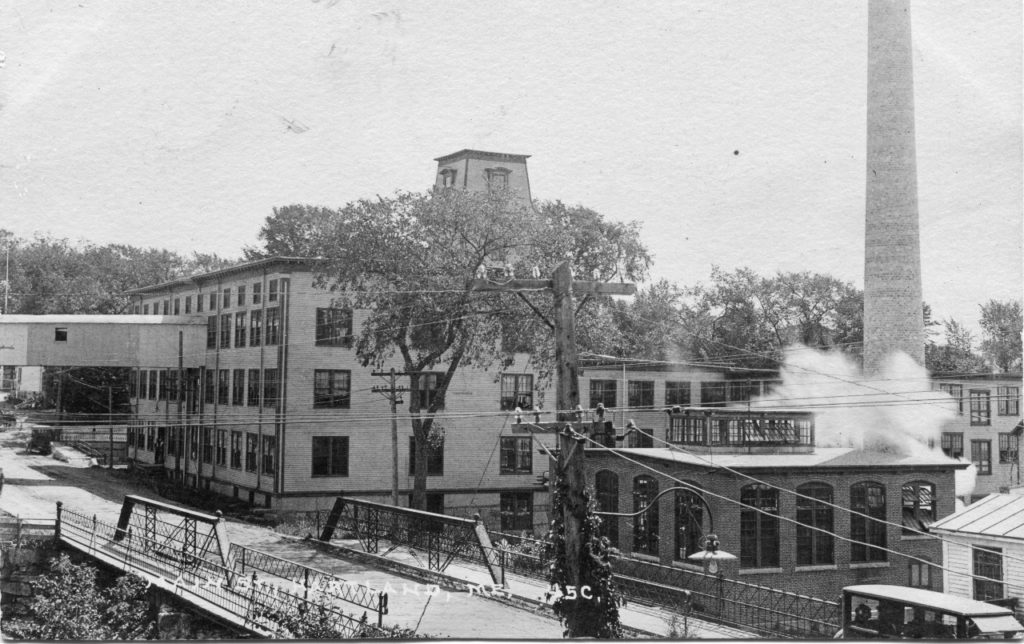
Home of the future Hartland Tanning Company
*
~ History of Tanning in Hartland ~
The first known tannery in the area was built in 1828 by brothers Hiram & Thomas Dorman on the lower side of the Sebasticook River Island when that section of Main Street was still part of St Albans. They sold the business in 1837 to Edward Hall Page, Jr and his son John Page of Bath. Following Edward’s retirement by 1850, John took over the business and was later joined by his son John S. Page operating as John Page & Son Tannery. During the Great Flood of 1887, the building suffered extensive damage and was purchased soon after by Archibald Linn who had built the original Linn Woolen Mill on the upper side of the Main Street in 1863. The Page Tannery was razed to make way for a new additional woolen mill with its construction beginning in 1890 by the heirs of Archibald Linn.
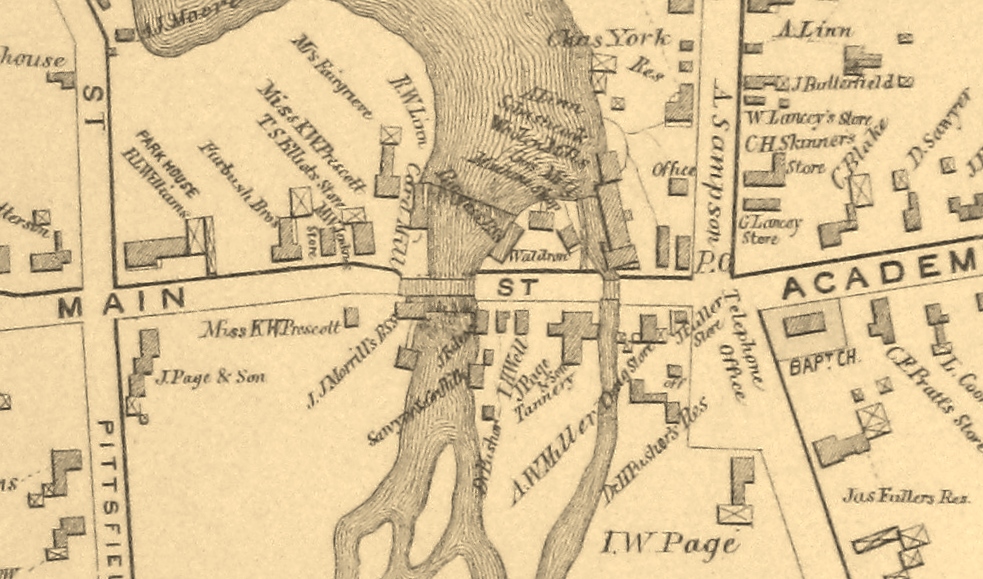
John Page & Son Tannery and original Linn Woolen Mill on Main Street – 1883
*
The second tannery in Hartland was built in 1856 by Isaiah Billings on North Street on the Upper Dam. Billings operated the business until 1867 when he sold it to Charles Shaw and his son Greenville Jefferson Shaw and moved to Iowa. The Shaws owned 4 tanneries by 1870 including locations in Detroit and Burnham but by 1878 were forced to close their other 3 tanneries due to a bark shortage. Tanning operations in Hartland continued until the Great Flood of 1887 which also severely damaged the Shaw Tannery. It was closed and razed soon after.
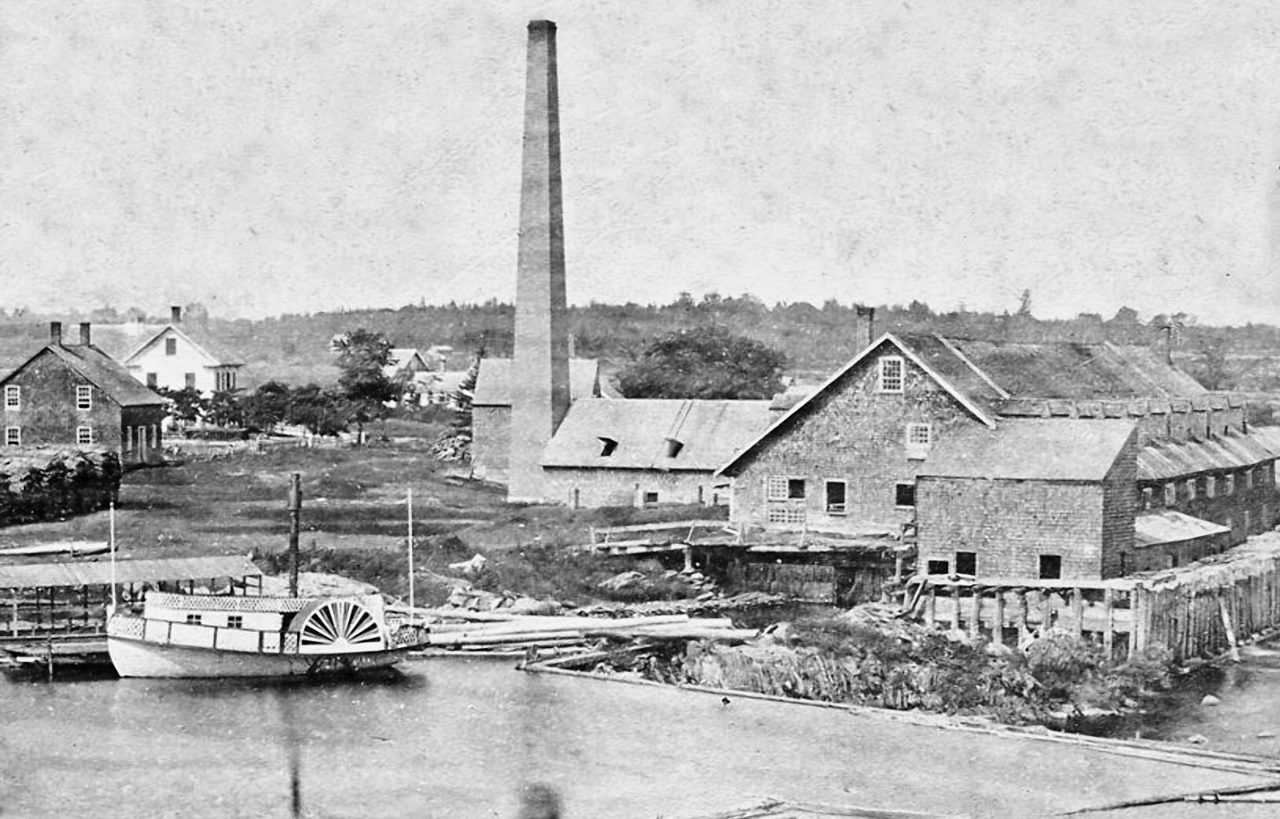
Shaw Tannery on North Street at Upper Dam – c1877
*
Meyer “Max” Kirstein, founder of the Irving Tanning Company, was a Polish immigrant who left his native land at age 13 and took a leather worker job in Peabody, Massachusetts. Because of his experience as a leather worker in Poland, he was paid $3.00 per week, high wages at the time. Max founded the Irving Tanning Company in Peabody in 1925 and one more tannery in Salem, Massachusetts. The name “Irving” was taken from the street on which he started his business. He began processing sheepskins, then splits, and then side leather. With the addition of the new Hartland Tanning Company, Irving Tanning Company then included Universal Tanning Company in Peabody, Massachusetts and a Sales Office in Boston.
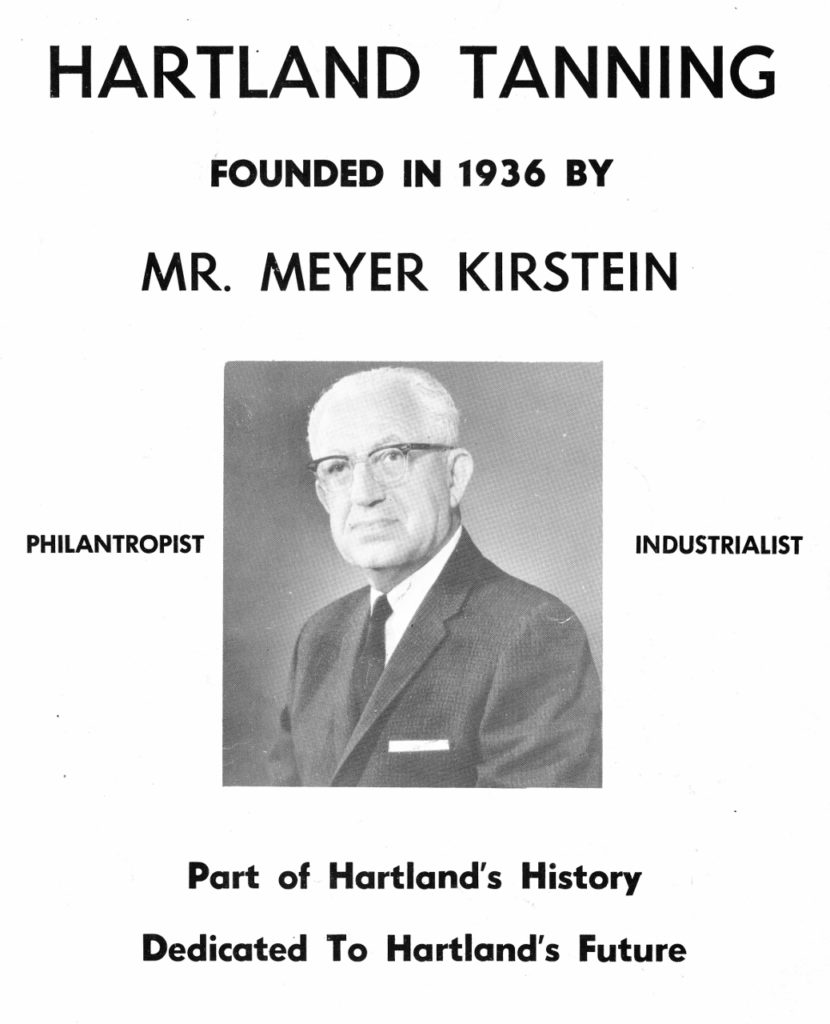
Meyer “Max” Kirstein (1897-1969)
*
One of the most complete documents concerning the history of Hartland Tanning Company was compiled by several employees of the company in 1994 including numerous first hand historical accounts, photos and personal stories. Click the link below for the entire original document.
Partners in Progress – A History of Irving Tanning Company and A Story of Its People
*
*
Although the Hartland Tanning Company successfully began operations in 1936, Hartland Mills, Inc. had leased the facility and still owned all the property & buildings. The lease contract included numerous improvement projects which needed to be completed by Hartland Mills, Inc. including installation of a generator with a water wheel at the dam to power it, installation of a sprinkler system as well as the disposal of several of the smaller buildings which sat on the island. Numerous other improvements included removing left over woolen machinery, repairing all the broken windows and repairs on the roof. Now that a new business had been secured and income was being received from the lease, Hartland Mills, Inc. could also begin paying dividends to its stock holders.
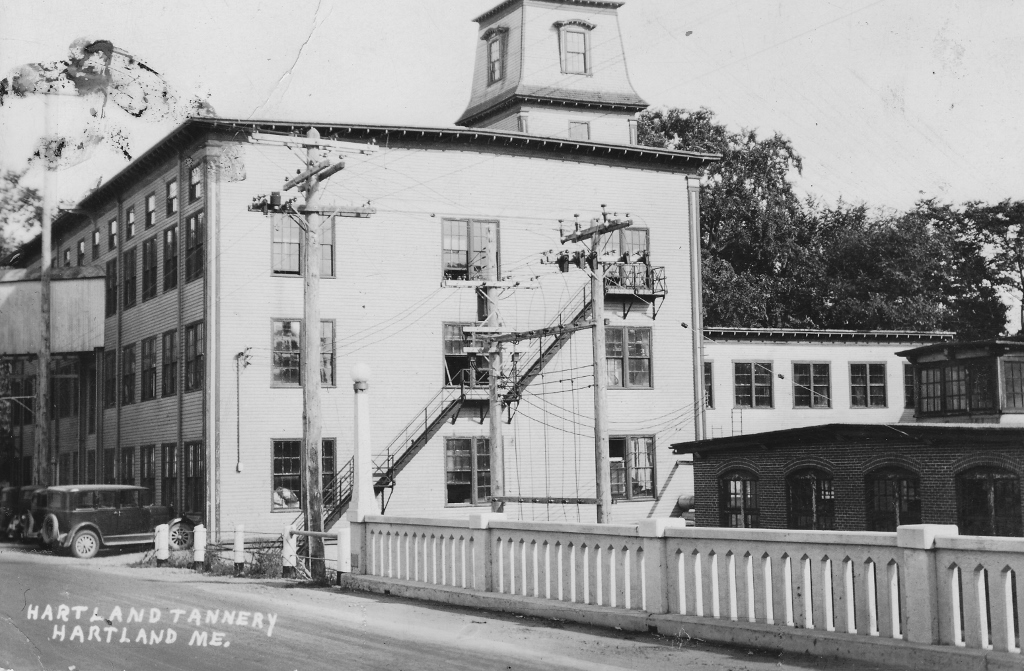
Hartland Tanning Company
*
More stocks still had to be sold by Hartland Mills, Inc. and training people with no leather making skills was paramount for producing a salable product. An agreement was drawn for all new Hartland Tanning Company employees to return 3 cents of their approximate 20 cents per hour wages for two years, the estimated time needed for proper training but within three months Mr. Kirstein rescinded the agreement and absorbed the expense allowing workers to keep their entire wages.
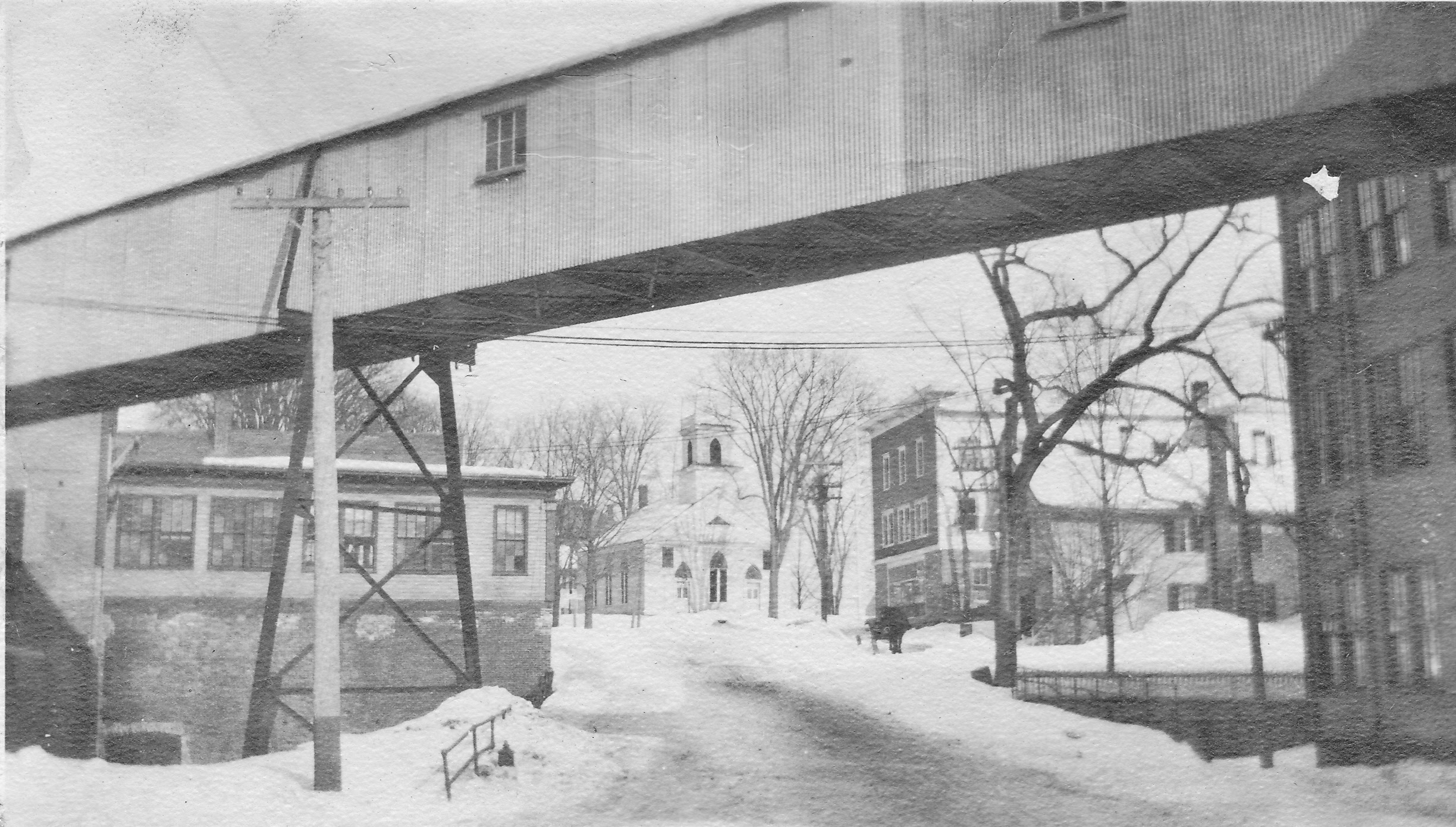
The Crossover between the 2 main mill buildings remains a familiar landmark on Main Street
*
One of Kirstein’s boldest and most successful business moves was hiring Daniel E. Connelly to run his Hartland Tanning Company operations as Plant Manager in 1947. Connelly, a well respected local resident, had been Plant Manager for H. C. Baxter & Brothers Canning Company in Hartland at the time and brought his management and people skills to the tannery playing a key role in its future success over the following 25 years.
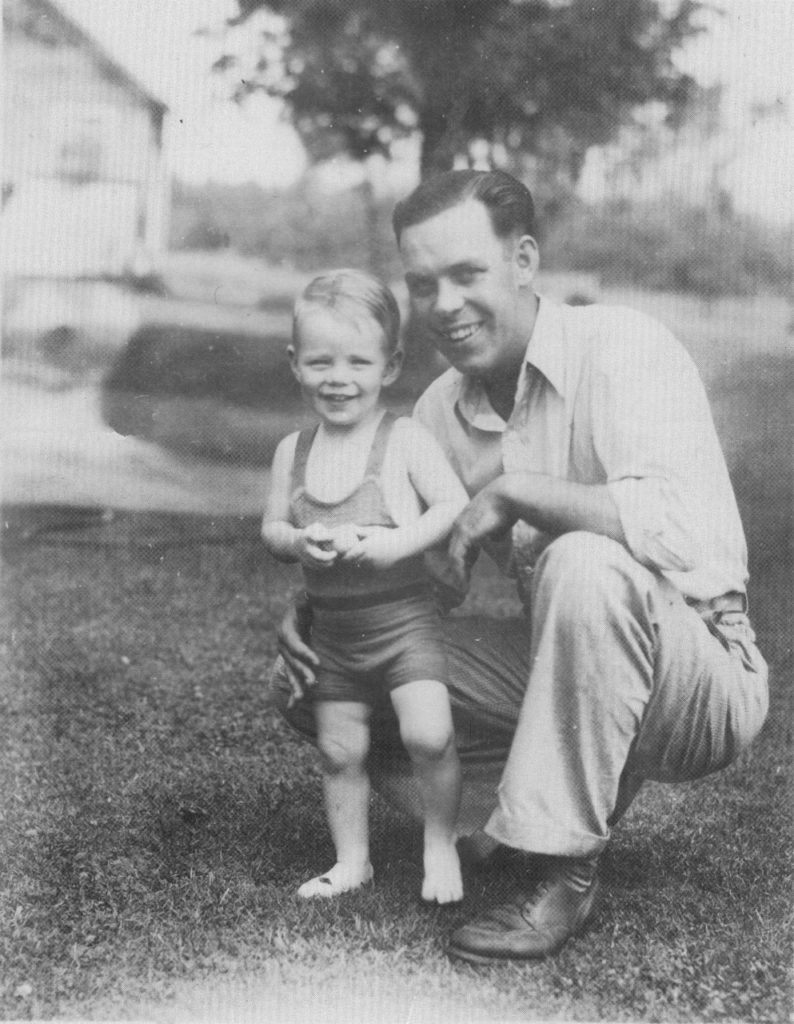
Daniel Elmer Connelly with son John W. Connelly – c1942
*
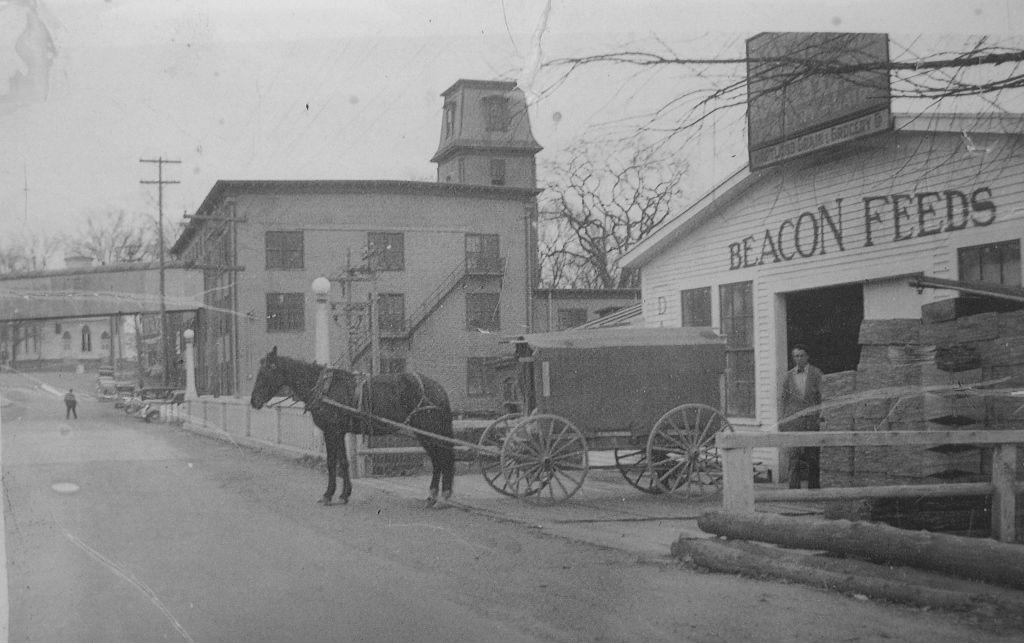
Hartland Tanning Company seen from Hartland Grain & Grocery – c1937 (Photo courtesy of Estelle Randlett Tapley)
*
The Boarding Machine in the Finish Department at Hartland Tanning was a notoriously dangerous machine to operate as noted by Hartland Historical Society Contributor Donald McDougal who also operated the machine in the late 1950s. Don tells us it was used to soften bag leather and give a crackle to the finish of the leather. It had two 14″-16″ rubber rolls with a knife edge in between where the leather was dragged in over the top and came out underneath. The operator had to stand on one leg and kick the foot treadle which activated the knife edge to swing in or out to release the leather however the rolls kept going all the time while you opened and closed it to put the leather into it.
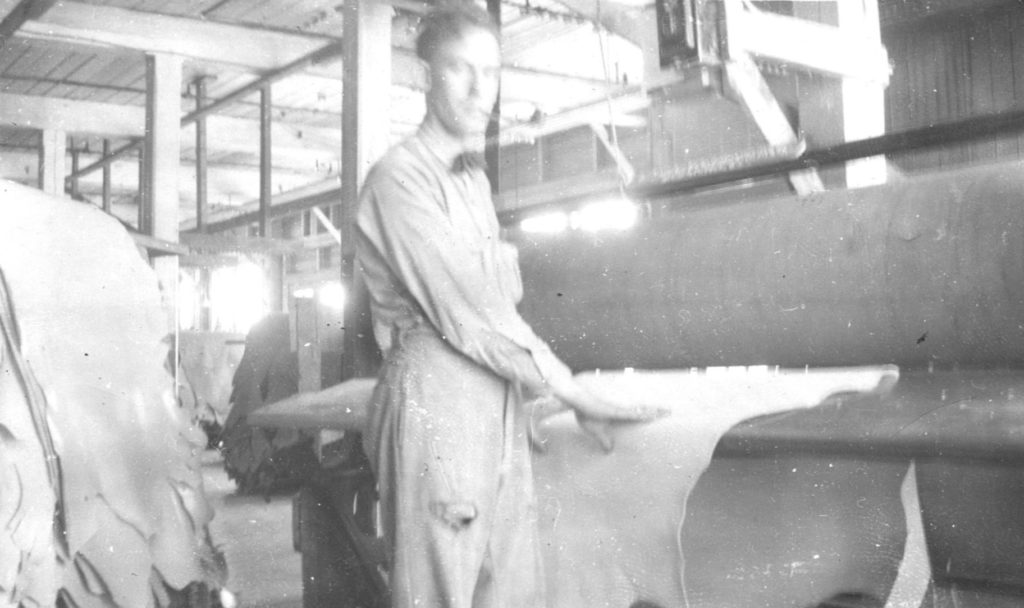
Hartland resident Robert “Pop” Perkins operating the Boarding Machine in the 1940s
*
In the 1940s, hides were brought in by rail and stored at the newly converted Tannery Hide House at the Hartland Train Depot on Lower Main Street. Hides were then trucked to the main plant as needed for many years by various drivers including Raymond Gregoire.
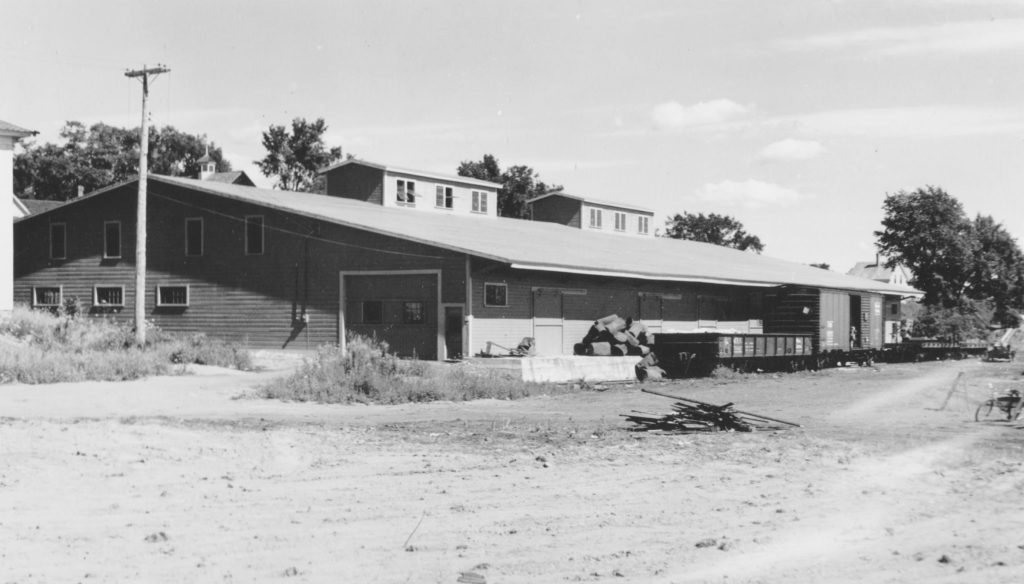
Hartland Tanning Company Hide House at Train Depot on Lower Main Street – c1945
*
Layout of Hartland Tanning Company from the 1945 Sanborn Fire Insurance Map.
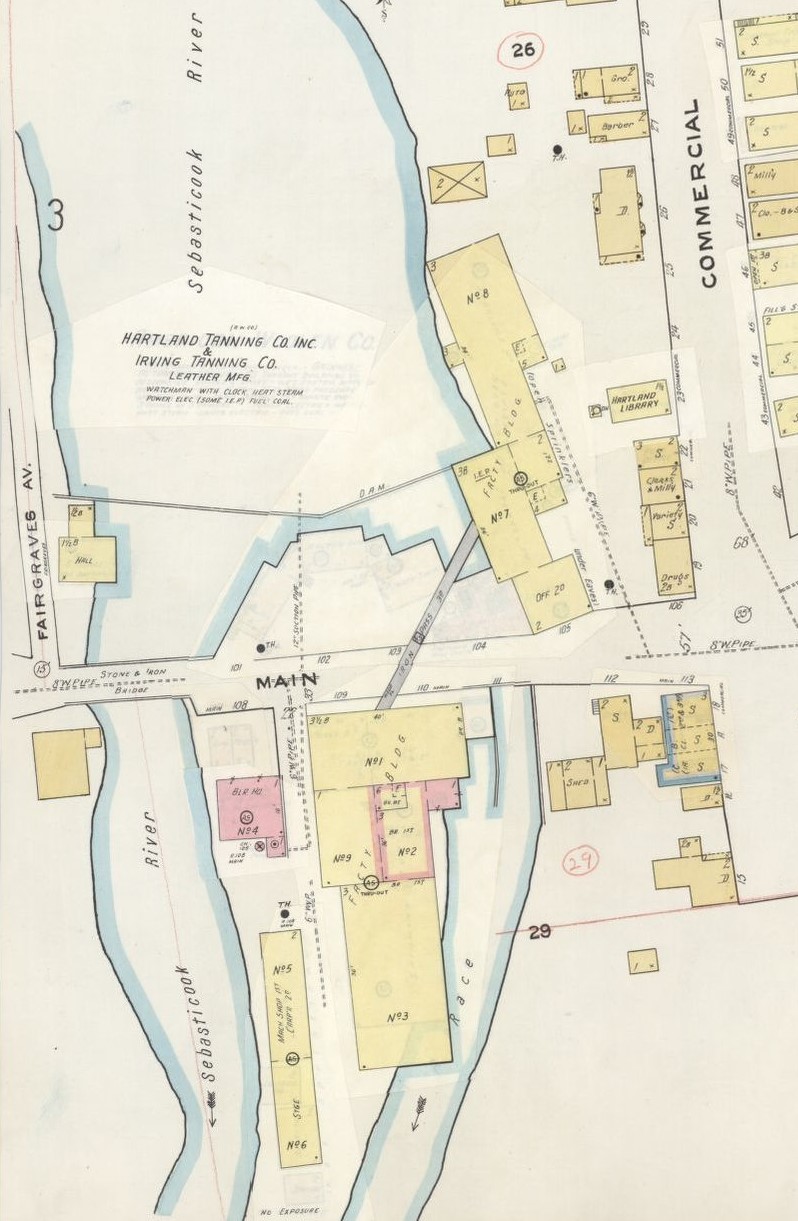
Hartland Tanning Company – 1945
*
A recent discovery in 2020 at the tannery revealed this plaque honoring its employees serving in World War II.
Our sincere thanks to Adam Parker & Tina Bowring for bringing this piece of history to the Hartland Historical Society for preservation.
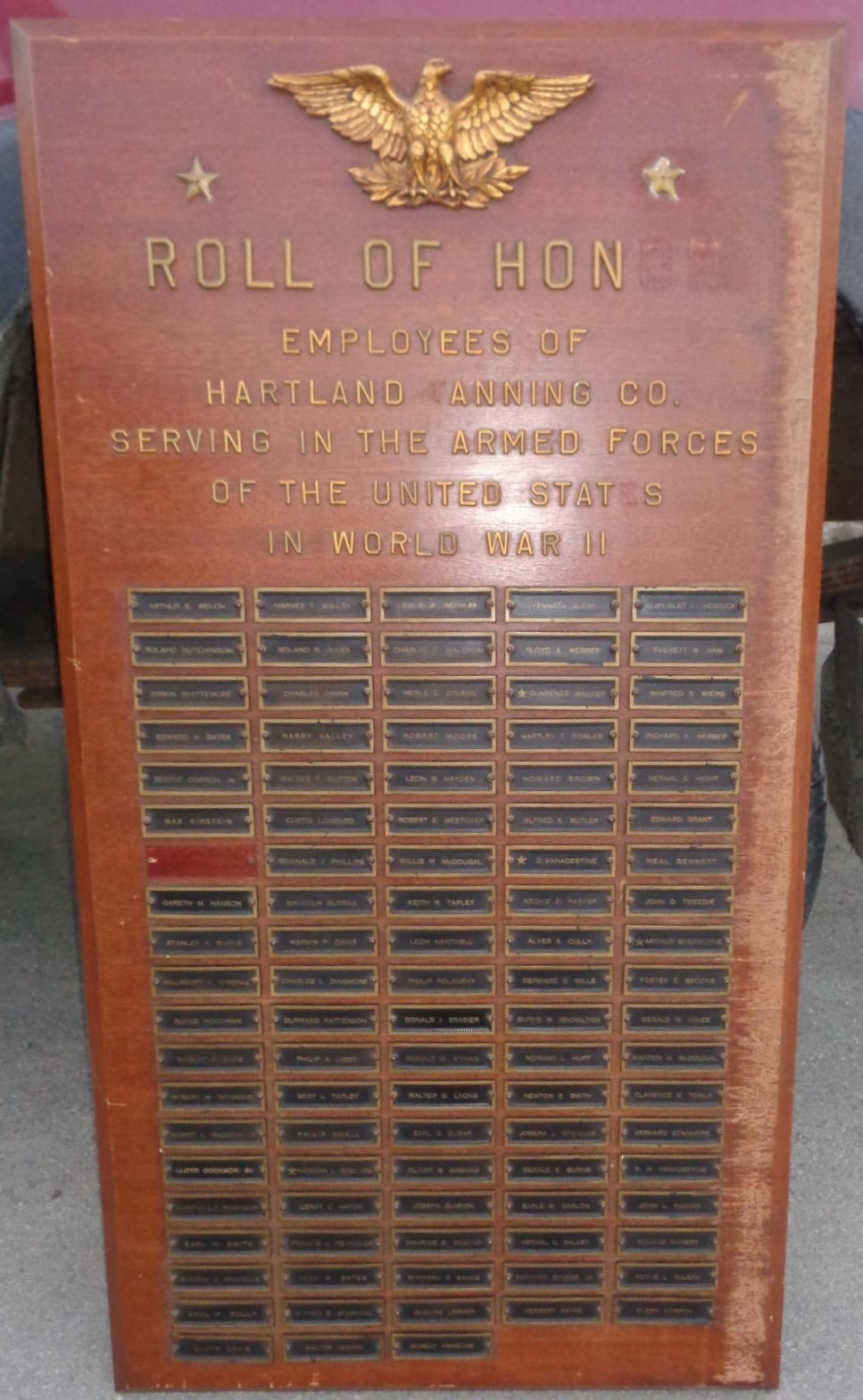
Hartland Tanning Company Honor Roll Plaque
*
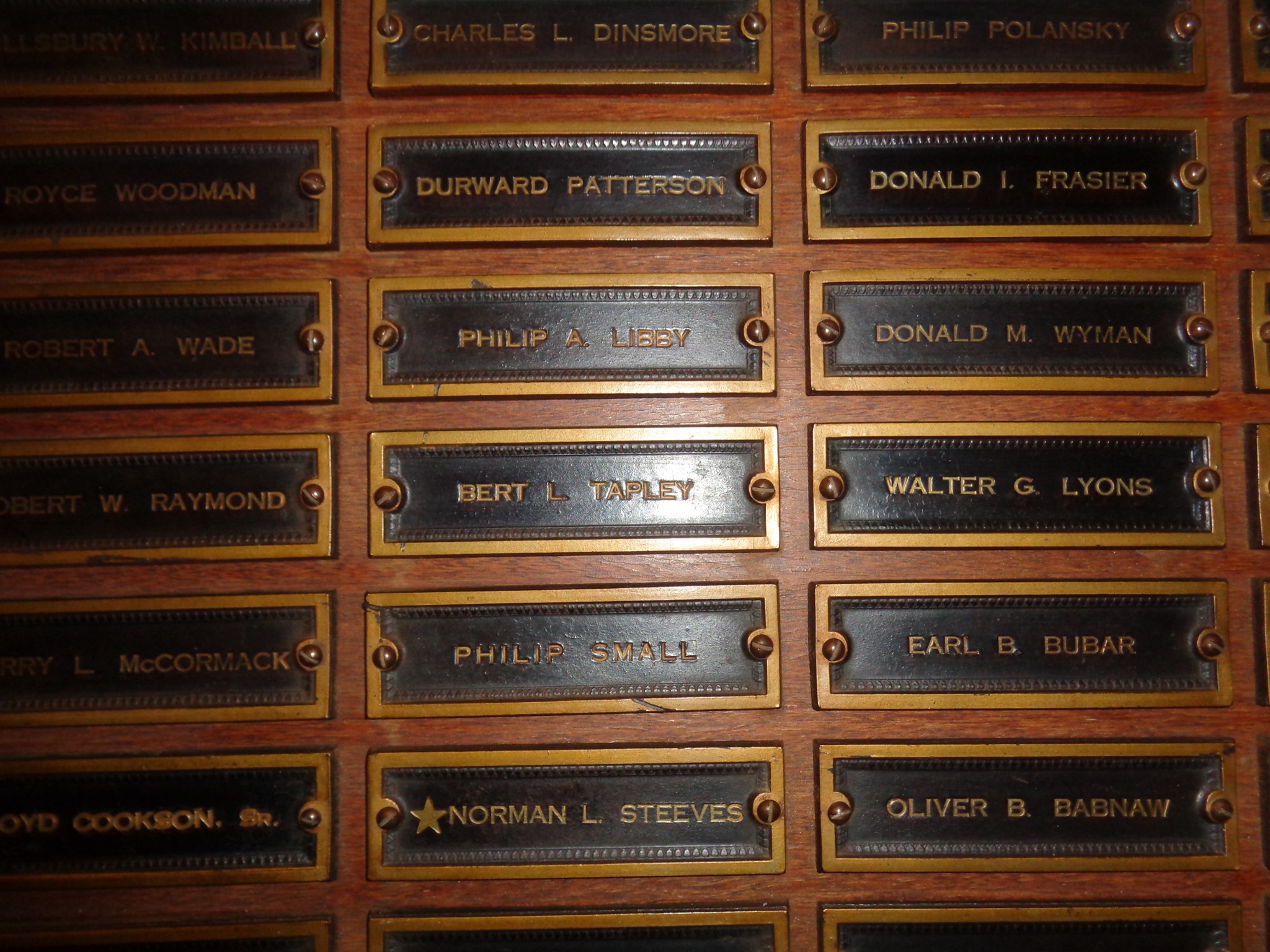
Close Up View of the Honor Roll Plaque
*
The names on the plaque have been transcribed below in order left to right:
EMPLOYEES OF HARTLAND TANNING CO.
SERVING IN THE ARMED FORCES OF THE UNITED STATES IN WORLD WAR II
ARTHUR E. WELCH | HARVEY E. WILLEY | LESLIE W. REDIKER | KENNETH WIERS | ELIPHALET L. HERRICK
ROLAND HUTCHINSON | ROLAND R. WILES | CHARLES F. WALDRON | FLOYD A. WEBBER | EVERETT W. HAM
ERWIN WHITTEMORE | CHARLES INMAN | MERRILL E. STUBBS | *CLARENCE E. WALKER | WINFRED S. WIERS
EDWARD H. BATES | HARRY SALLEY | ROBERT MOORE | HARTLEY T. FOWLER | RICHARD A. WEBBER
BENNIE COOKSON, JR | WALTER T. NUTTER | LEON M. HAYDEN | HOWARD BROWN | VERNAL E. HIGHT
MAX KIRSTEIN | CURTIS LOMBARD | ROBERT E. WESTOVER | ALFRED E. BUTLER | EDWARD GRANT
MISSING NAME TAG | REGINALD J. PHLLIPS | WILLIS M. McDOUGAL | *DONALD E. VANADESTINE | NEAL BENNETT
GARTH M. HANSON | MALCOM BURRELL | KEITH R. TAPLEY | ARCHIE D. PARKER | JOHN D. TWEEDIE
STANLEY A. BURNS | MARVIN P. DAVIS | LEON HARTWELL | ALVER A. CULLY | *ARTHUR W. SHERBURNE
MILLSBURY W. KIMBALL | CHARLES L. DINSMORE | PHILIP POLANSKY | DERWARD S. MILLS | FOSTER E. BROOKS
ROYCE WOODMAN | DURWOOD PATTERSON | DONALD I. FRASIER | BURNS W. KNOWLTON | GERALD WHINES
ROBERT A. WADE | PHILIP A. LIBBY | DONALD M. WYMAN | NORMAN L. HUFF | WARREN H. McDOUGAL
ROBERT W. RAYMOND | BERT L. TAPLEY | WALTER G. LYONS | NEWTON E. SMITH | CLARENCE E. TOWLE
MURRAY L. McCORMACK | PHILIP SMALL | EARL B. BUBAR | JOSEPH L. SPENCER | VERNARD STANHOPE
LLOYD COOKSON, SR | *NORMAN L. STEEVES | OLIVER B. BARNAW | GERALD E. BURNS |RICHARD H. VANADESTINE
MARSHALL K. ROBINSON | LEROY C. HATCH | JOSEPH QUIRION | EARLE W. CARLOW | JOHN L. PARKER
EARL H. SMITH | FRANCIS L. REYNOLDS | MAURICE E. SAWYER | VERNAL L. SALLEY | ROLAND RUMSERY
EUGENE J. REOPELLE | IVAN M. BATES | SHERMAN R. SANDS | BERNARD STUBBS, JR | VERNEL McLEAN
EARL P. CULLY | ALFRED E. STAFFORD | ISADORE LERNER | HERBERT BATES | ELDON CORSON
LLOYD DAVIS | WALTER HEWINS | ROBERT PARSONS
(* Missing or Killed in Action)
*
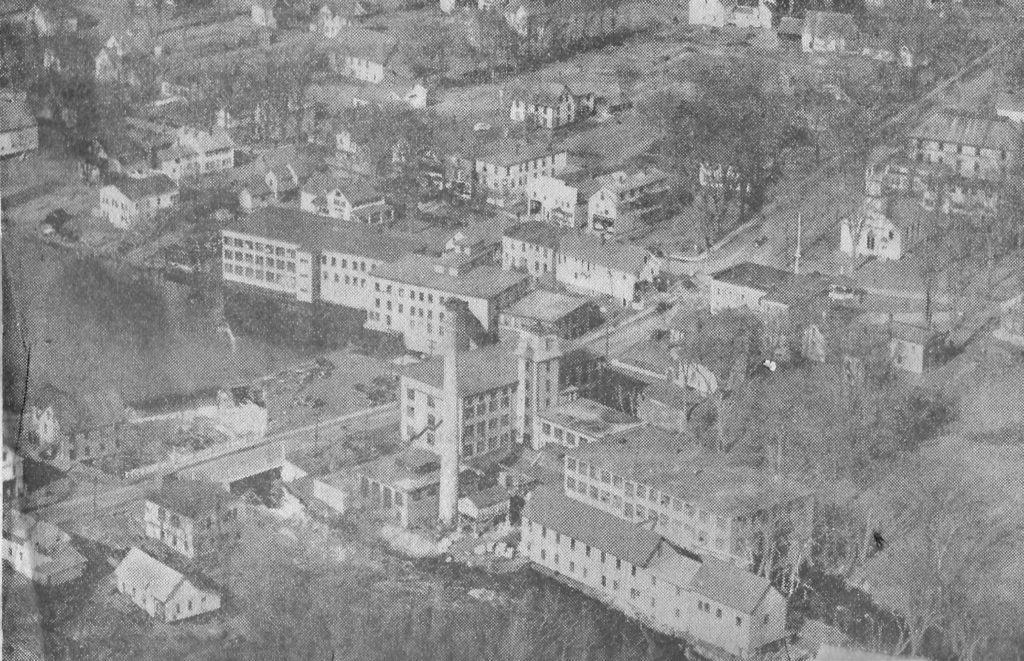
Hartland Tanning Company – 1949
*
By 1955, the Hartland Tannery was producing 1,500 sides per day but needed considerable more space to expand production. Local residents, led by Hartland Citizens, Inc., then endorsed a bond issue, guaranteed by Irving Tanning Company, that would raise sufficient additional funds to build a new facility on Main Street to house operations from soaking to shaving and increase production to 6,000 sides per day.
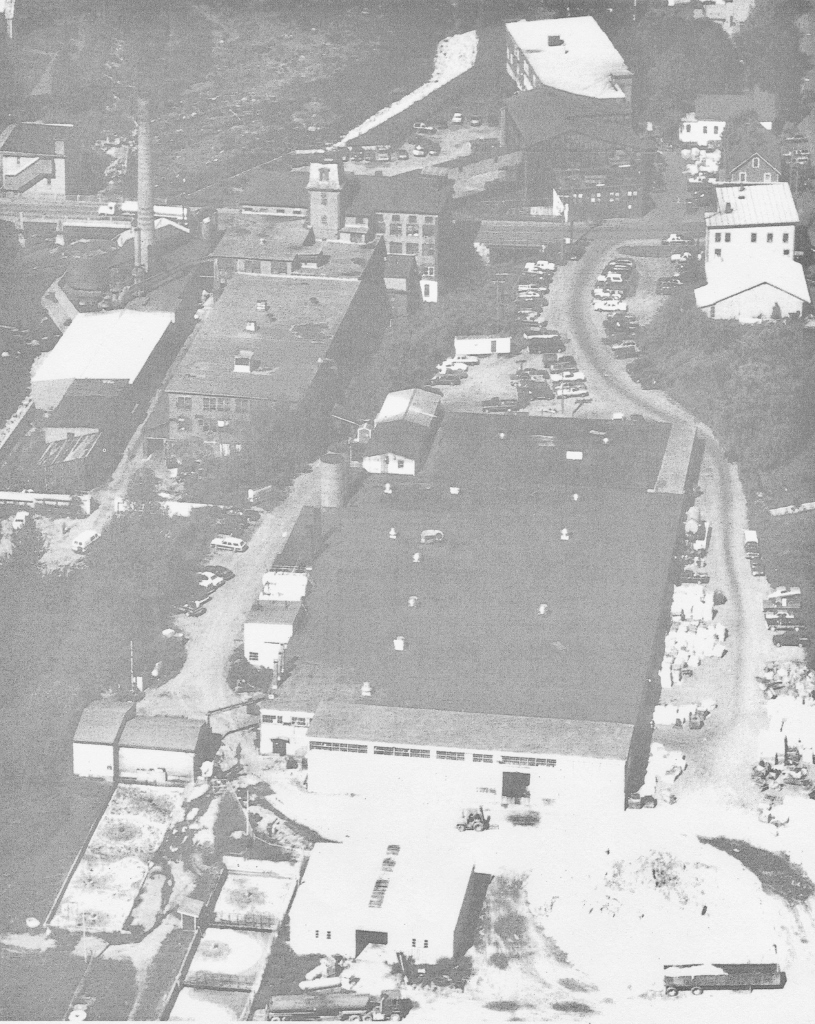
New Hartland Tanning Company Beam House – 1956
*
A couple of renditions of the proposed new plant were presented before its construction.
Our sincere thanks to Adam Parker & Tina Bowring for bringing these to the Hartland Historical Society for preservation.
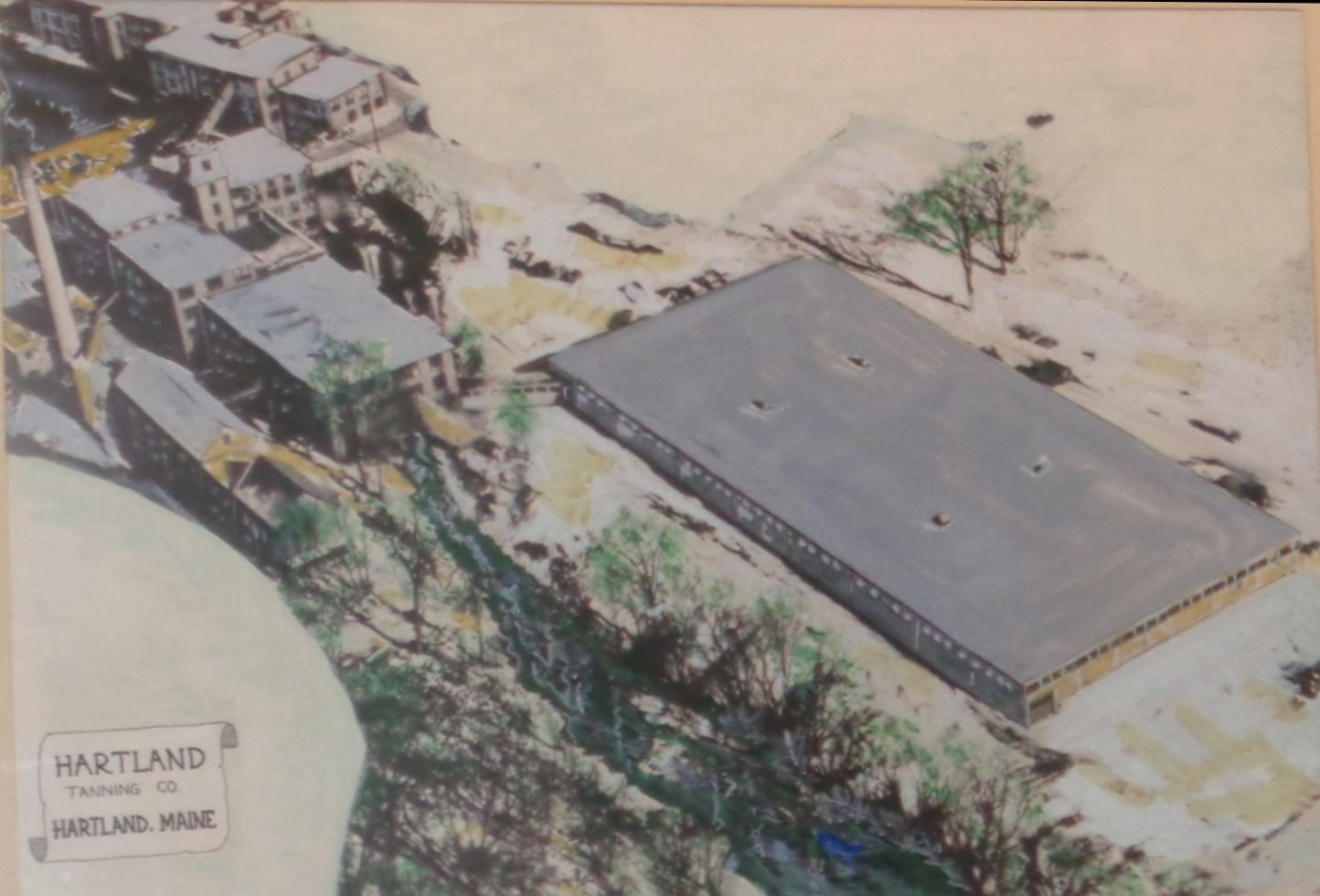
*
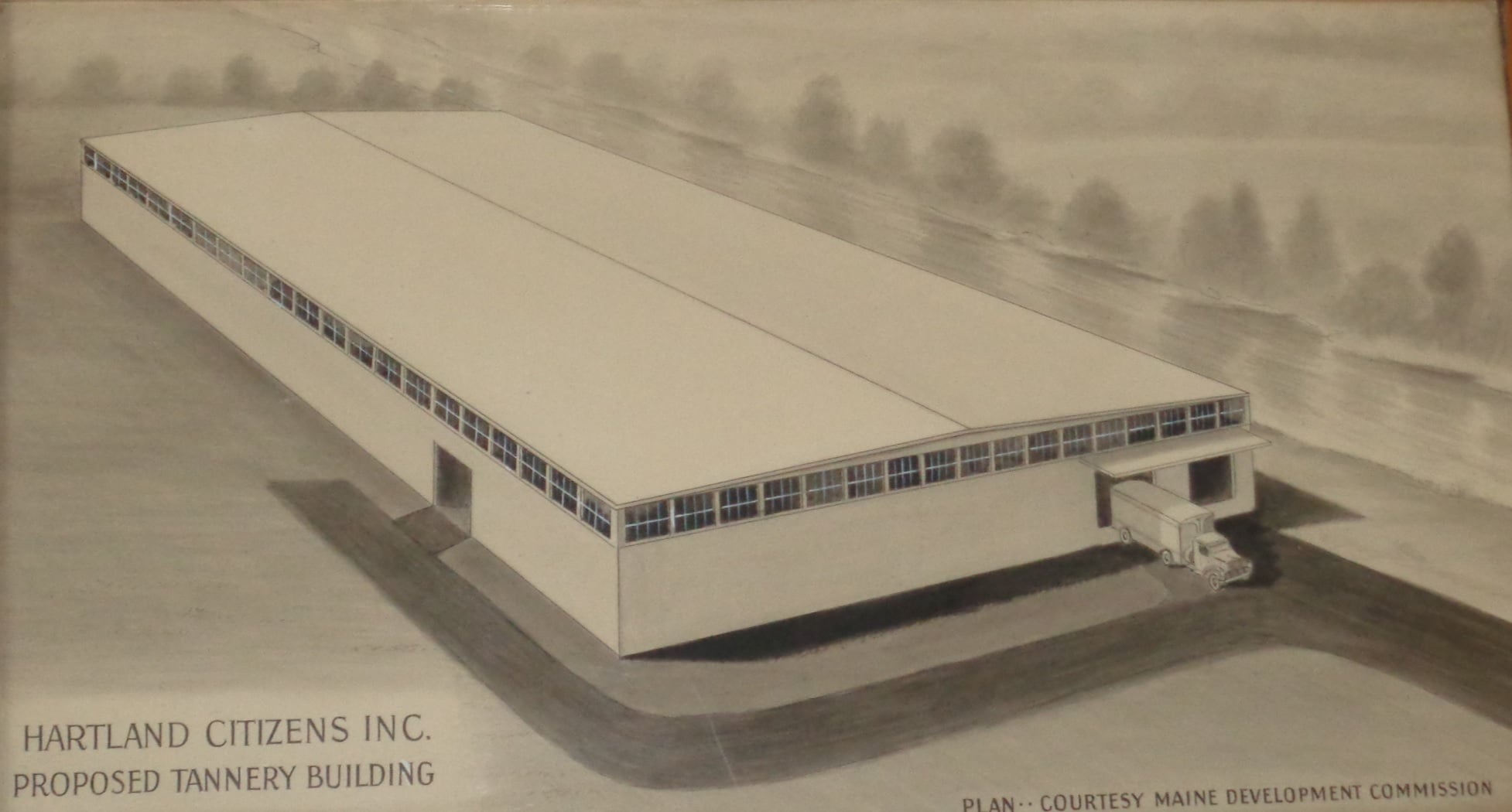
Future Beam House Renditions
*
A Grand Opening was held at the new plant on July 16, 1956 which became known as the Beam House.
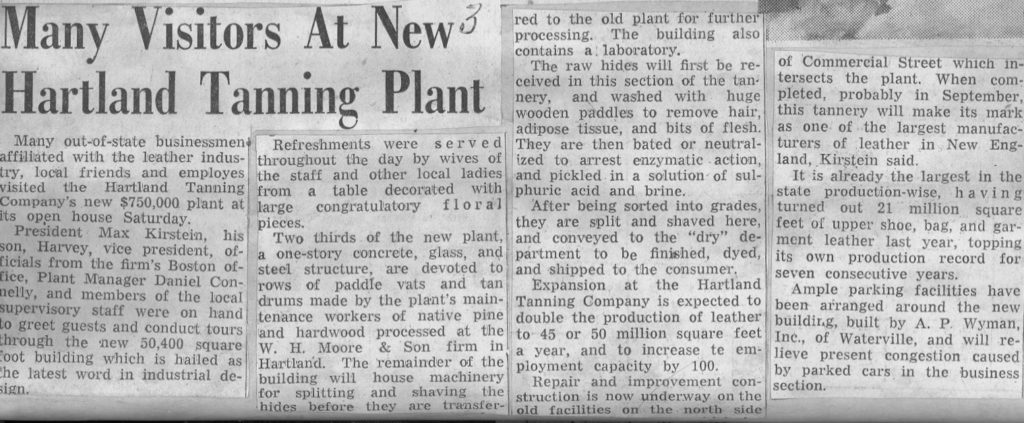
Beam House Grand Opening Article – July 16, 1956
*
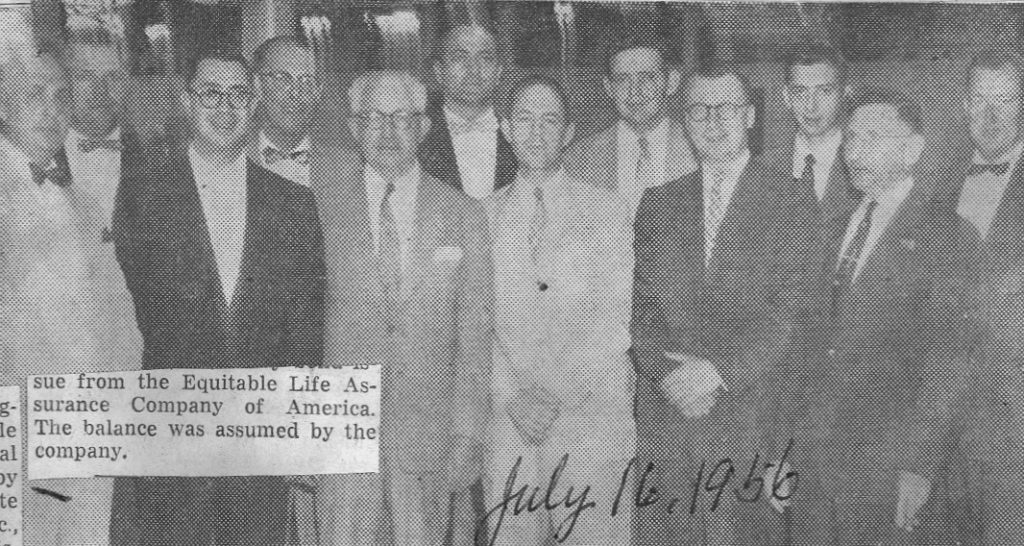
Beam House Grand Opening Article – July 16, 1956
*
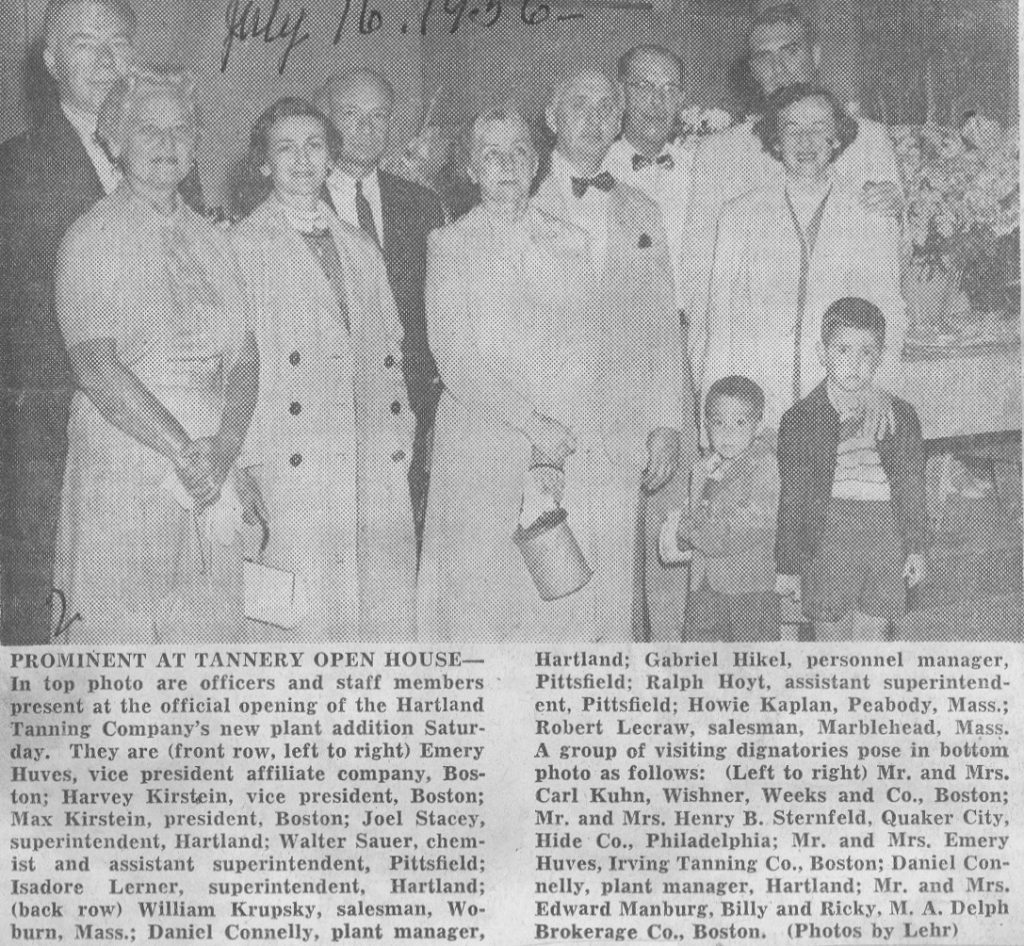
Beam House Grand Opening Article – July 16, 1956
*
In 1957, a new site was acquired at the former Atlas Plywood Plant in Howland and Pine Tree Tanning Company (now a division of Irving Tanning Company) began operations for side leather production. Production at Pine Tree Tanning soon increased to 3,000 sides a day and combined with Hartland Tanning, they would ship as much as 55 million square feet of leather a year, which was 8% of all leather made in the United States. At that time, Maine was the fourth largest producer of footwear leather in the country.
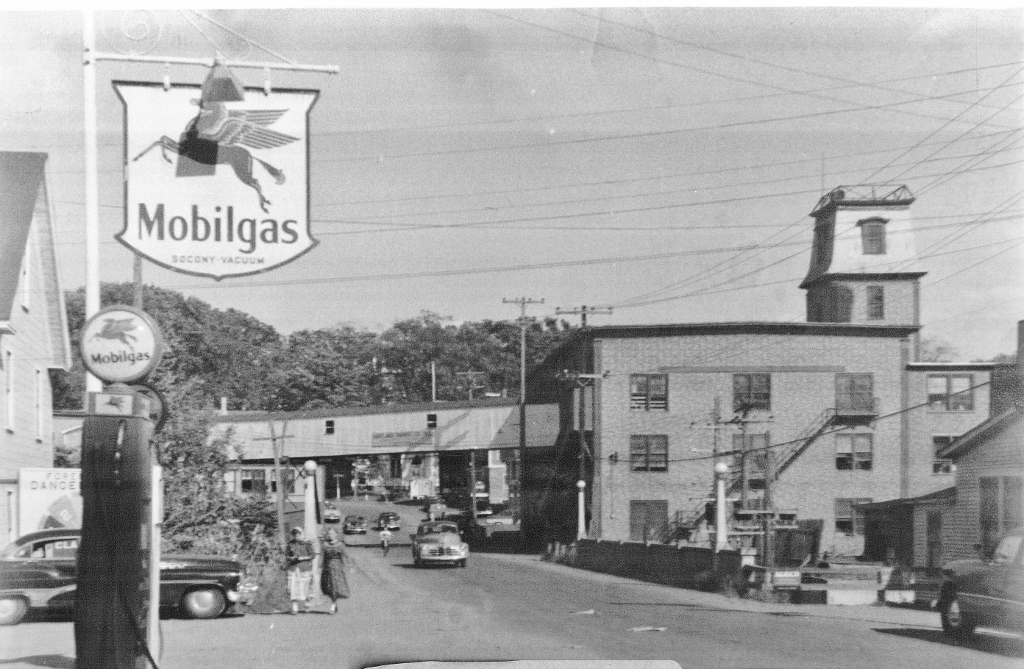
Hartland Tanning Company – 1956
*
Hartland Tanning Company Officers & Foremen Meeting – Lancey House, Pittsfield – 1957
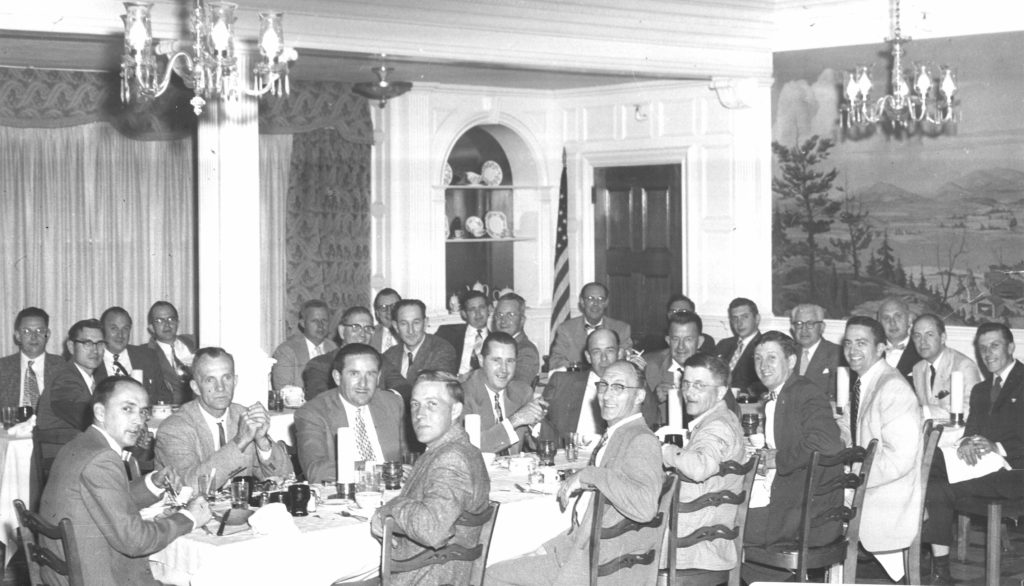
Back Row from the Left: Don Pelkie | Elwood Allen | Tom Kelso | Earl Buker, Jr | Jim Krupsky | Rudolph Snow | Walter Sauer | Fred Libby | Ralph Hoyt | Dan Pelkie | Dan Connelly | Isadore Lerner | Howie Kaplan | Meyer Kirstein | Emery Hunas | Joel Stacey | Lindy Bradstreet
Around the Table, Clockwise from the Left: Dick Webber | Arnie Cummings | Arthur Firestone | Jake Reifschneider | Don Randlett | Vaughn Chadbourne | Gabe Hikel | Don Hollister | Joseph Spencer | William Brawn | Linwood Wheeler
*
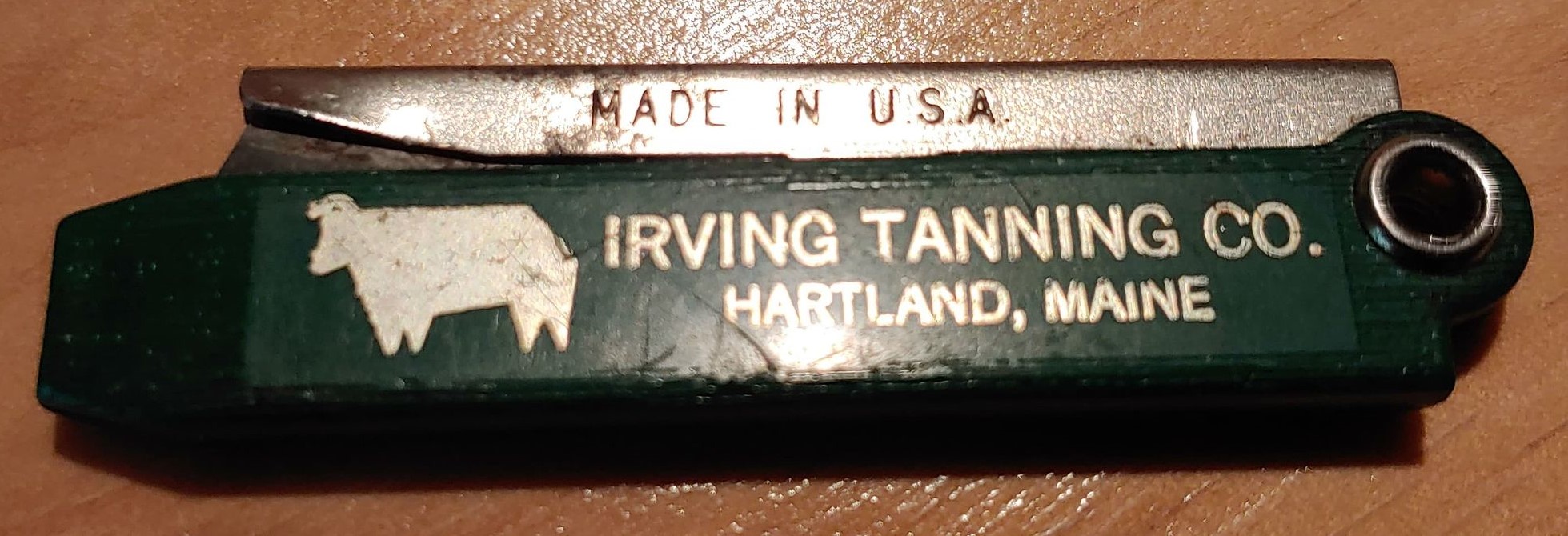
Irving Tanning Company Box Cutter (Photo courtesy of Sam Fuller)
*
Meyer Kirstein presenting awards.
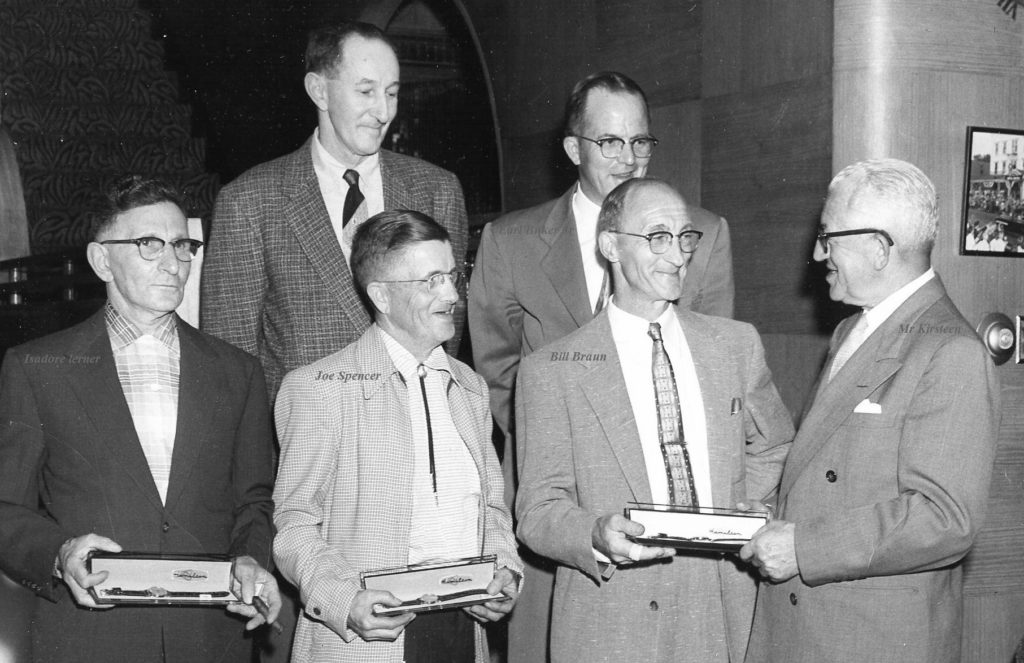
(L-R) Front Row: Isadore Lerner | Joe Spencer | Bill Braun | Meyer Kirstein | Back Row: Fred Libby | Earl Buker, Jr
*
Following the 1961 closure of H. C. Baxter & Brothers Canning Company on Outer Pleasant Street, the facility and property was purchased and converted into an Annex by the Irving Tanning Company. Several processes were transferred from their Main Street plant to the Annex including final trimming and shipping.
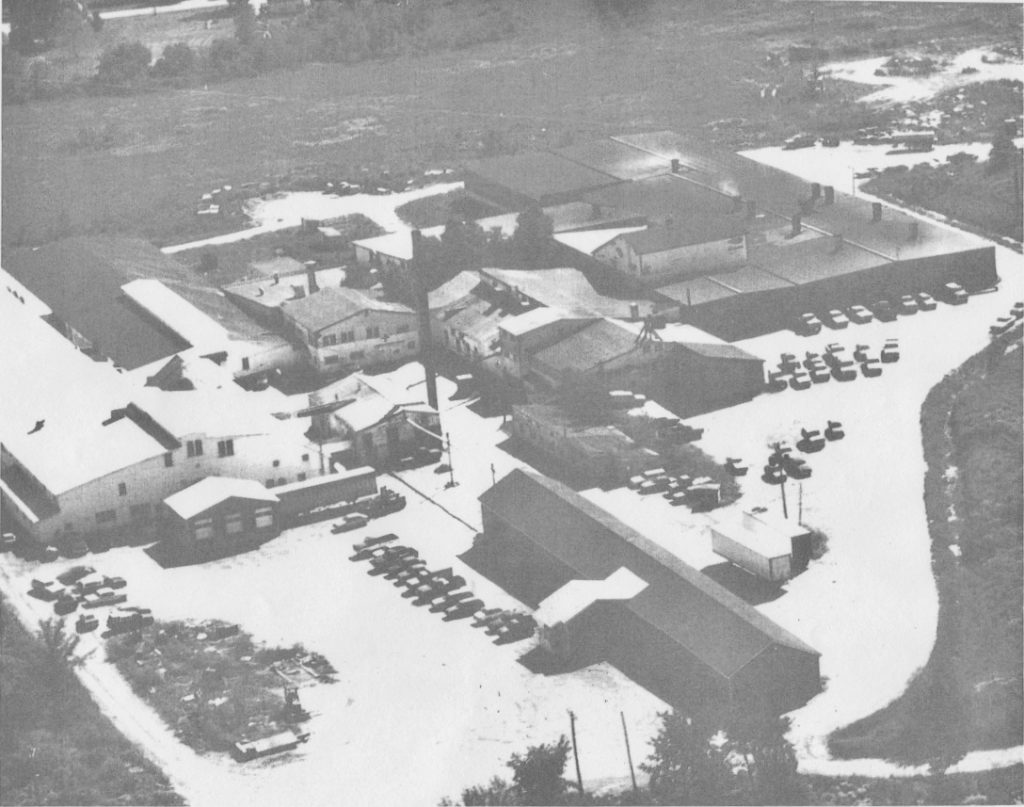
Irving Tanning Company Annex on Pleasant Street
*
Throughout his years in business in Hartland, Meyer Kirstein supported numerous fund raising efforts in town as well as the surrounding communities. He donated an organ to the Methodist Church & Baptist Church in Hartland, the Episcopal Church in Palmyra and the Catholic Church in Pittsfield. He also donated towards the elevator purchase at Scott-Webb Memorial Hospital and furnishing two rooms at the hospital. When the Hartland Town Swimming Pool Committee was formed in the mid 1960s, he matched what the Town raised to install the pool.
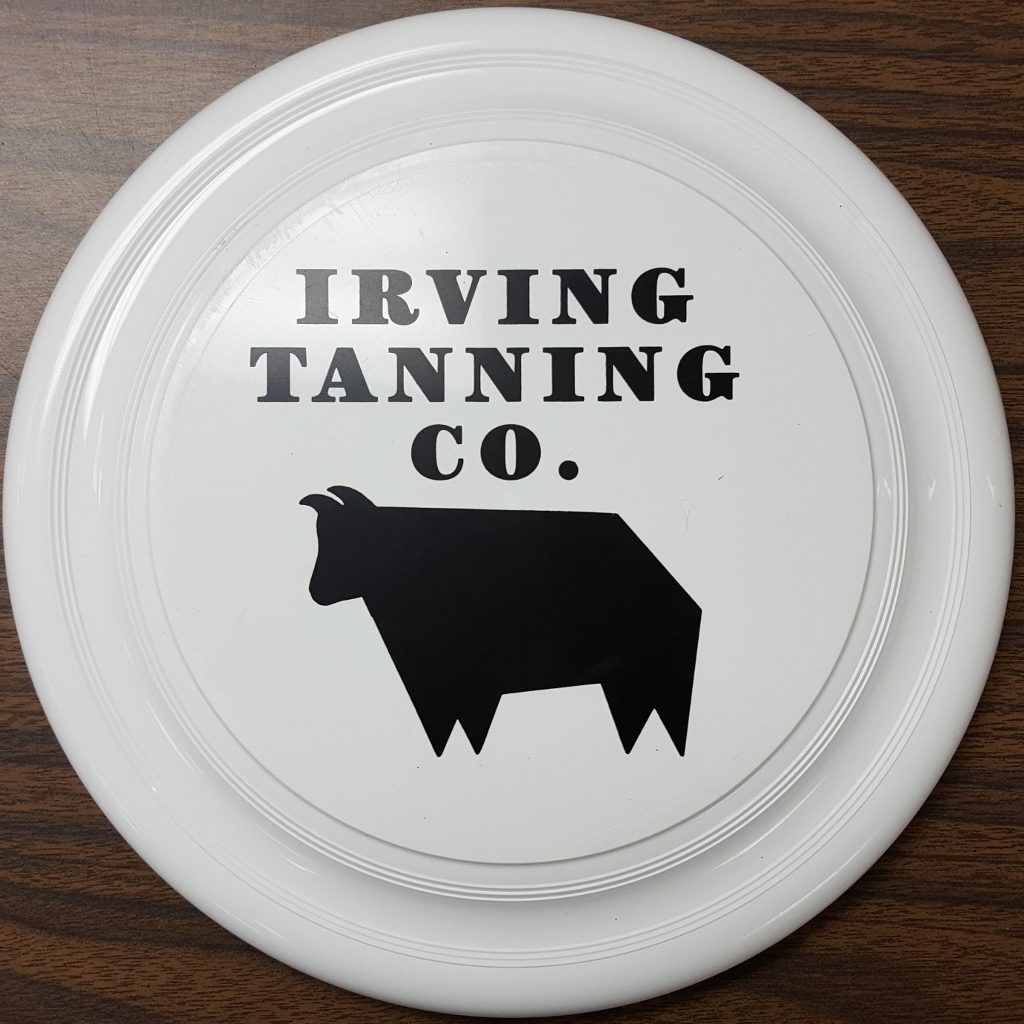
Irving Tanning Company
*
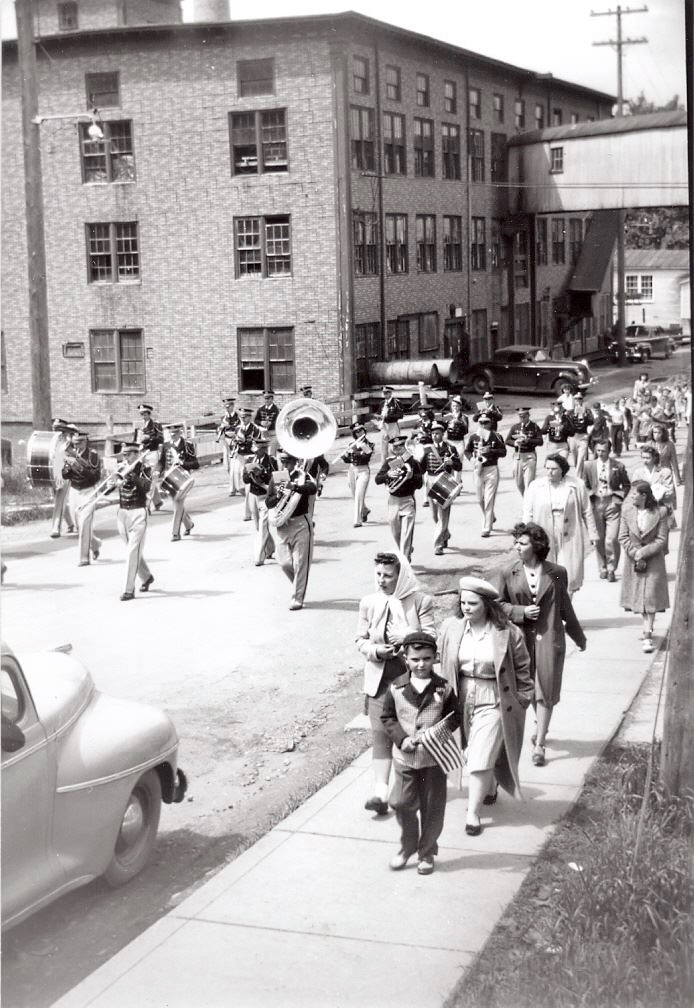
Memorial Parade passes Irving Tanning Company on Main Street – c1959
*
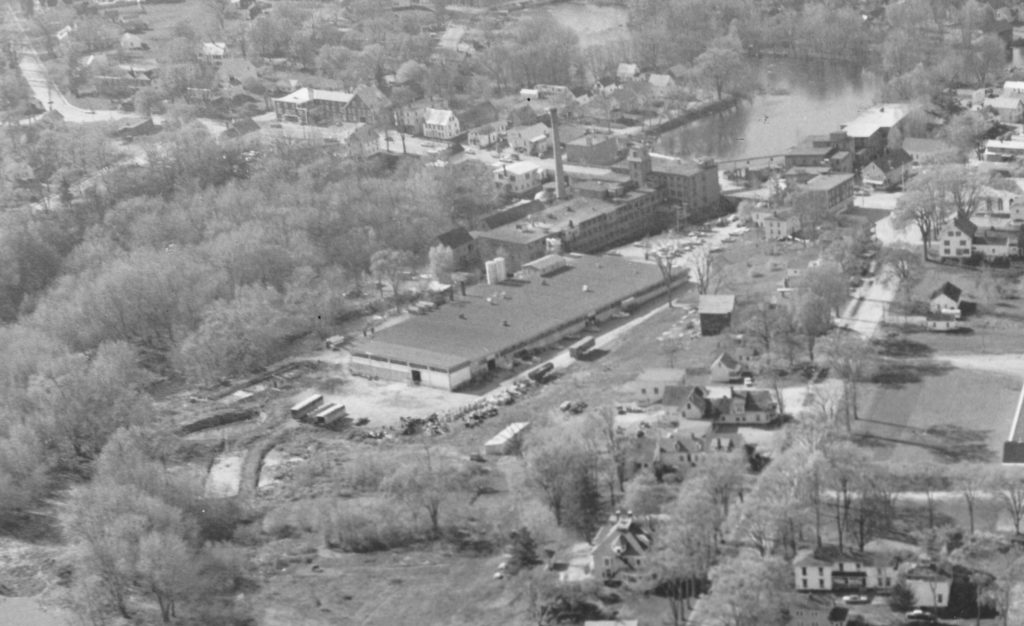
Irving Tanning Company – 1970
*
~ Seagrave Corporation ~
In 1962, Mr. Kirstein began negotiations for the sale of Irving Tanning Company. The company was sold to the Seagrave Corporation, a holding company consisting of diversified divisions, whose shares were listed on the New York Stock Exchange.
*
In 1969, the Irving Tanning family suffered a tragic loss when Meyer Kirstein, beloved founder and friend to everyone, passed away.
*
In the mid-1980s, a major new exterior siding project revitalized the looks of the century old buildings.
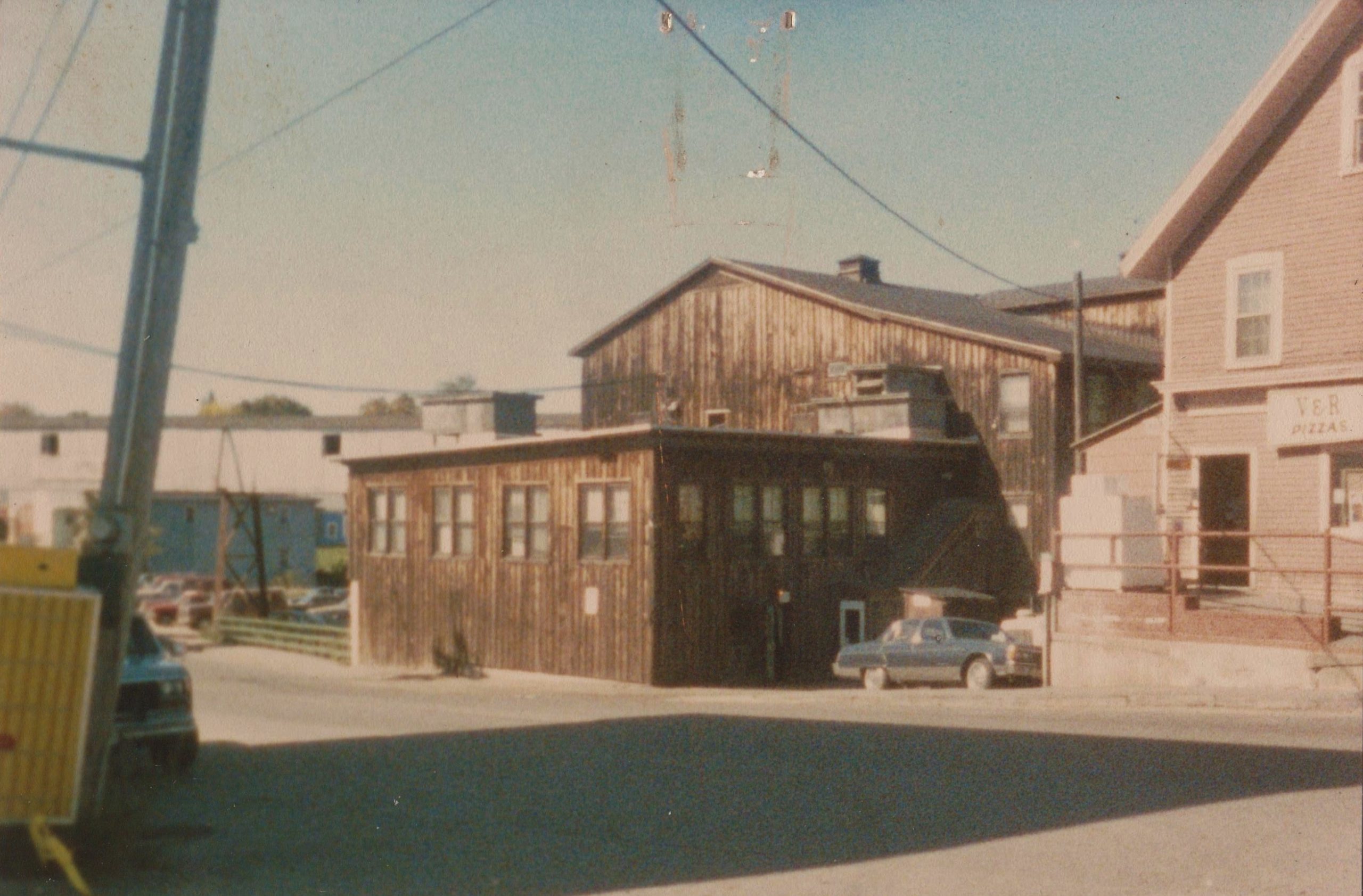
Irving Tanning Company Upper Building – 1987
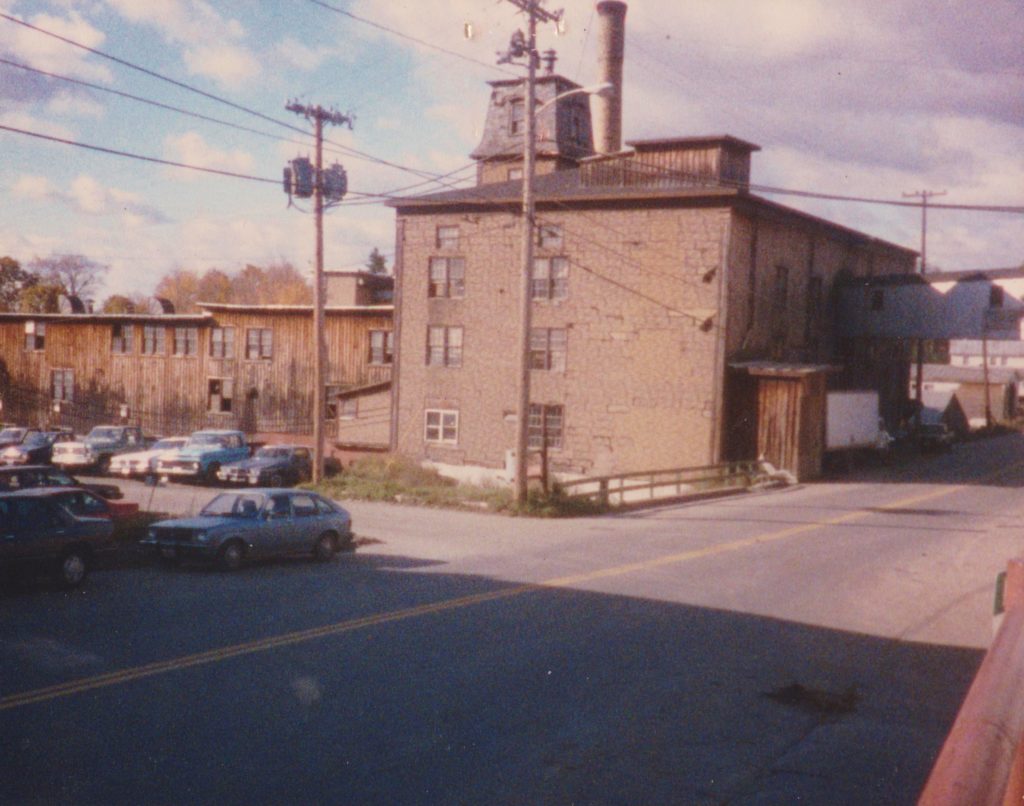
Irving Tanning Company Lower Building – 1987
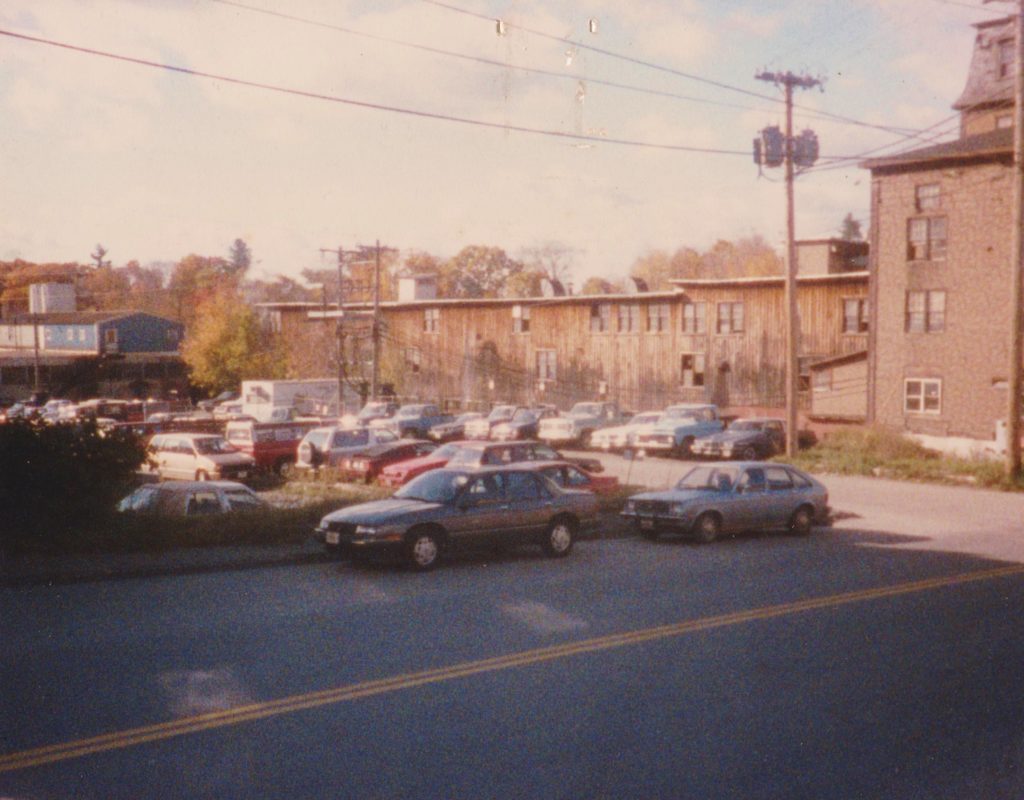
Irving Tanning Company Lower Building & Beam House – 1987
*
The infamous “April Fool’s Day Flood” in 1987 ravaged Main Street and the surrounding area once again but fortunately occurred after the town had removed and rebuilt the entire Lower Dam region which included a flood retaining wall preventing another catastrophic flooding event.
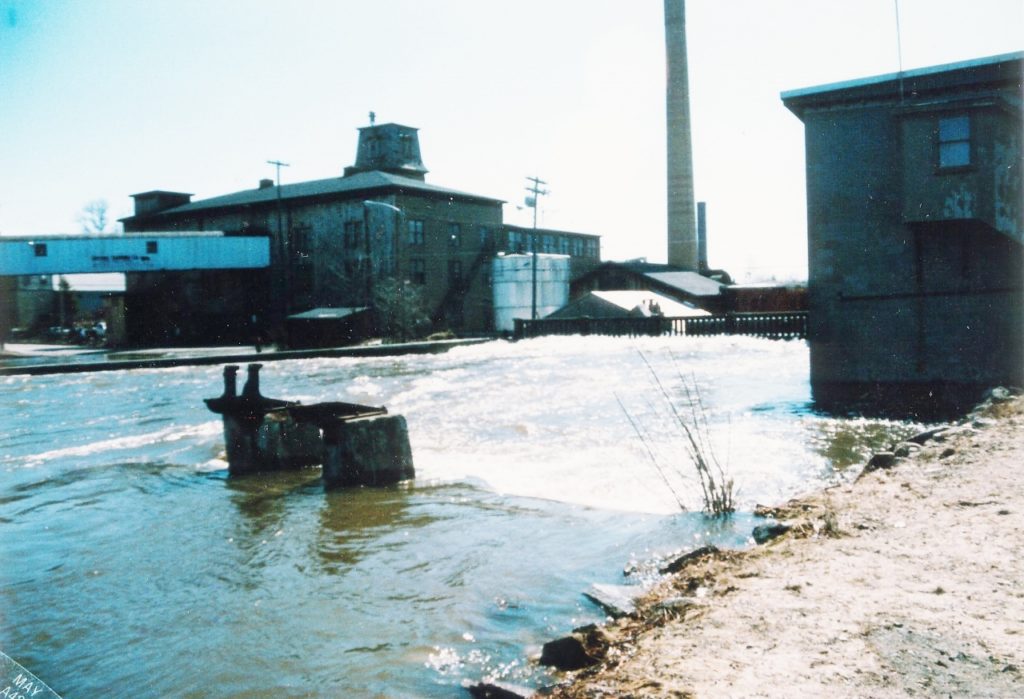
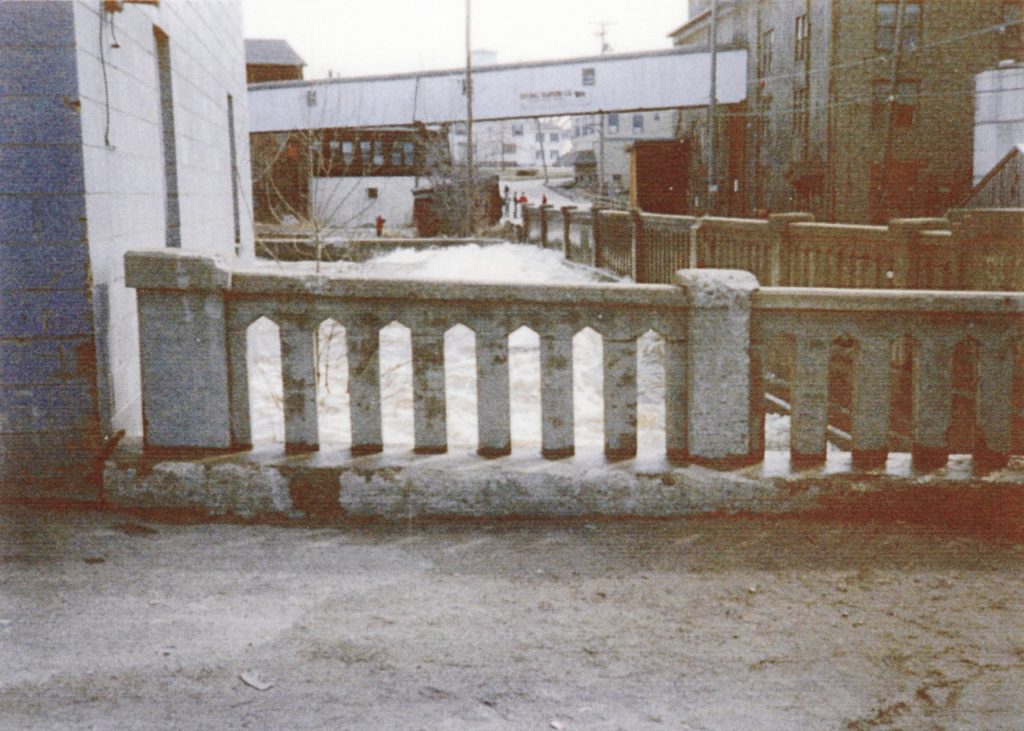
*
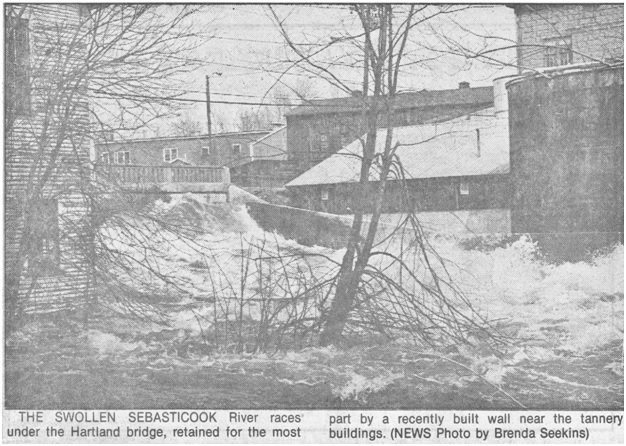
“April Fool’s Day Flood” of 1987
*
~ Vista Resources, Incorporated ~
The Seagrave Corporation sold all its operations except the leather division including the corporate name to become Vista Resources, Incorporated composed of Irving Tanning in Hartland, Hancock Tanning in Ellsworth, Wilton Tanning in East Wilton and Kroy Tanning in Salem, Massachusetts. In 1990, the controlling interest in Vista Resources, Incorporated was assumed by the Fuqua Family of Atlanta, Georgia. They began a massive modernization plan laid out in two phases to bring the plant back into its place in the international tanning community.
Phase I called for Reorganization and Capital Investment. $13 million dollars was invested in new construction, renovation, new machinery, equipment and programs for employees. It was decided to close the Hartland Beam House in 1991 and to purchase “Wet Blues” from the Midwest which would solve a number of environmental problems. Great efforts were made to curtail the use of toxic materials and minimize the discharge of VOC. (Volatile Organic Compounds) A decision was also made to go from ladies weight leather to men’s weight, as the light weights were moving rapidly offshore to Third World countries.
Phase II called for a Modernization Plan which began in 1992 and continued into 1994. These modernization projects elevated Irving Tanning to one of the largest and most technologically advanced tanneries in the world. Irving once again took its place in the international tanning community. The international influence of Irving was enhanced by an award in 1993 to Irving Tanning for quality of product and efficiency of operation, as determined by DNV, a global association with its ISO 9000 Certificate (International Standardization Organization).
In March of 2005, Irving Tanning Company filed Chapter 11 Bankruptcy after its mortgagee, TD Bank North, pulled the credit line which affected capital funding for the company. By September of 2005 the tannery emerged from bankruptcy to be sold to Meriturn Partners, LLC.
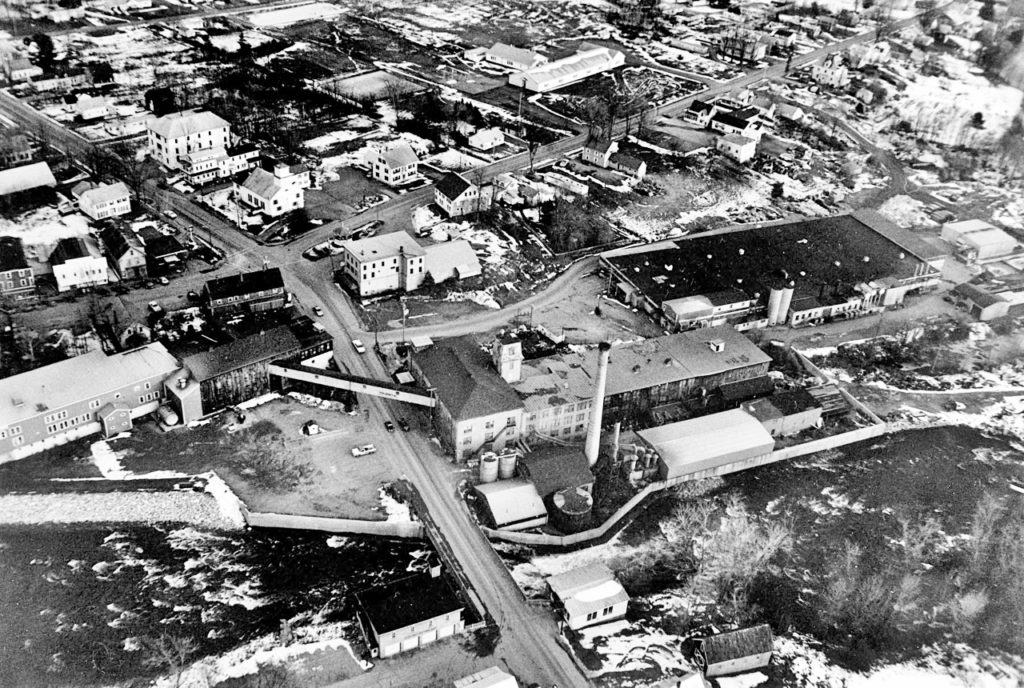
Irving Tanning Company following the Lower Dam Removal Project – 1986
*
~ Prime Tanning Company ~
In August of 2007, Irving Tanning merged with Prime Tanning Company. Irving Tanning was operating a 30 million foot capacity of side leather finishing operation in Hartland while Prime Tanning operated a similar size facility in Berwick, Maine as well as a Wet Blue operation in St. Joseph, Missouri. The Wet Blue facility in St. Joseph was sold in 2009.
In November of 2007, Prime Tanning Company announced its merger with Cudahy Tanning Company of Milwaukee, Wisconsin. Operations of the combined companies created the largest premium leather producer in North America with revenues in excess of $250 million dollars. As a result of the merger, Cudahy’s side leather finishing was transferred to the Hartland facility and the Cudahy plant was closed in May of 2008. Cudahy’s customers broadened Prime’s brands to include footwear, accessories, and specialty leather brands.
Prime Tanning Company announced in March of 2008 its intention to merge with Shanghai Richina Leather Company, LTD, but this was later suspended by mutual consent. Prime Tanning Company ceased leather finishing at its Berwick, Maine plant in August of 2008 and moved its production volumes into the Hartland facility. The consolidation was to improve profitability and efficiency thru domestic reorganization. Prime Tanning in Hartland operated the largest side leather finishing tannery in North America, with an annual capacity of over 30 million feet.
Prime was the dominate supplier to the branded footwear market, supplier for the luxury leather goods and accessory market, provider of upholstery leather for furniture craftsmen and military leather applications, as well as research and development for specialty markets.
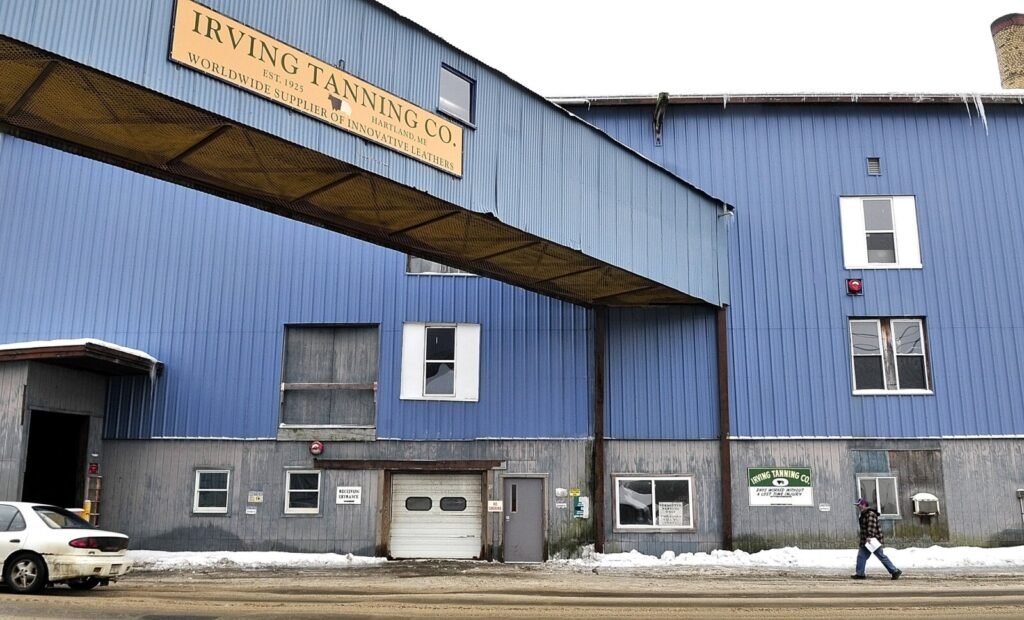
Irving Tanning Company – 2011
*
~ Tasman Leather Group ~
In 2011, the Tasman Leather Group acquired the Hartland Prime Tanning Company tannery, one of the most recognized finishing tanneries in the world. According to the company, “The facility located in Hartland had fallen under hard financial times, but maintained a talented and highly skilled group of American leather makers that would be a shame to stand by and fall to the wayside. After acquiring the tannery, we spent countless hours restoring the vintage facility and getting the heart and soul back into the leather. During this massive transition, we came across hundreds of precious formulas from deep within our tannery archives.”
In business since 1947, Tasman Leather Group is a family owned processor and supplier of premium leather produced in the United States for footwear, military items, garments, handbags and hospitality purposes to the global market. By 2014, its combined tanneries were producing approximately 160,000 hides per week with 1 of every 4 cattle hides in the USA coming through a Tasman facility. The company makes high quality leather items for U.S. brands and the U.S. Armed Forces and owns specialized formulas used to create better known leathers including those sold under the Pitstop, Rage, Oldtown, Retro, Ram Tough and The Original Crazy Horse brands.

Tasman Leather Group – Hartland Tanning Operations – 2019 (Photo courtesy of Will Bunker Photography)
*
~ The End of an Era? ~
Morning Sentinel Article by Amy Calder – May 4, 2020
The Tasman Leather Group announced Monday that declining demand for leather products because of the Coronavirus Pandemic has forced it to begin decreasing operations with the intention of closing its tannery facility in Hartland by late summer.
Norman Tasman, President of Tasman Leather Group, said Monday in a company-issued statement that officials are “deeply disappointed to end the tannery’s extended history, the last nine years of which are the product of a major restructuring and restart when the current ownership took control of the Prime Tanning Company facility.”
“The commitment and support that we received from our employees and our customers as we sought to adapt to structural changes in our markets has been remarkable,” Tasman wrote. “However, the global COVID-19 Pandemic has had a devastating impact on the demand for our product, and reinstatement of that demand is uncertain both in timing and magnitude, making continued operations impossible. As a result, we will begin winding down our operations with a goal of closing the Hartland plant in late summer.”